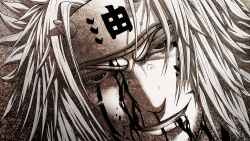The 100 Best Anime Movies is a list of the top anime movies that Japanese animation has produced. It offers a thorough aesthetic, technical and historical breakdown of why these films are the best. to put on the list. With the rise of anime in recent years, it can be hard to know where to start. This list of the top 100 anime movies offers a thorough aesthetic, technical and historical breakdown of why these films are so influential and essential
The 100 Best Anime Movies is a list of the best anime movies of all time. It's a great resource for anime fans who want to know what the best anime movies are.
The list is as follows:
100. The Boy and the Beast (2015)
Director: Mamoru Hosoda
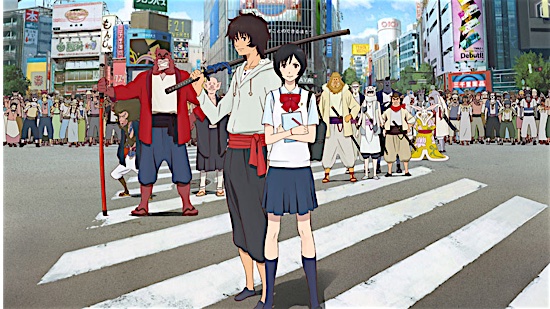
Mamoru Hosoda is championed as one of the greatest anime directors working today. That reputation is owed in no small part to him being touted as the heir apparent to the cinematic legacy of Hayao Miyazaki, who formally retired from directing following the release of his then-final film The Wind Rises in 2013. Despite this glowing association, few of Hosoda’s handful of films have managed to graze the same strata of cinematic accomplishment and canonical enshrinement that typifies the storied career of the Studio Ghibli luminary.
Such is the case with The Boy and the Beast. The story follows that of Ren, an orphaned boy who, after stumbling through an Alice in Wonderland-style passageway into a world of mythical creatures, is adopted as a pupil by the brash and indolent swordmaster Kumatetsu, who vies to become the lord of all beasts. All of the surface components of a great film are there, with stunningly crisp animation, charged fight scenes, and a tasteful use of computer graphic imagery to accentuate these sequences. However, The Boy and the Beast is hamstrung by an over reliance on supporting characters narrating the emotional arcs of the protagonists instead of letting them speak for themselves, and a weak grasp of story structure and character motivations exemplified by a ponderously sporadic middle-half. In spite of these shortcomings, The Boy and the Beast remains a visually impressive and entertaining film to watch that puts all of Hosoda’s abilities and indulgences as a director on display, for better or worse.
99. Mobile Suit Gundam F-91 (1991)
Director: Yoshiyuki Tomino
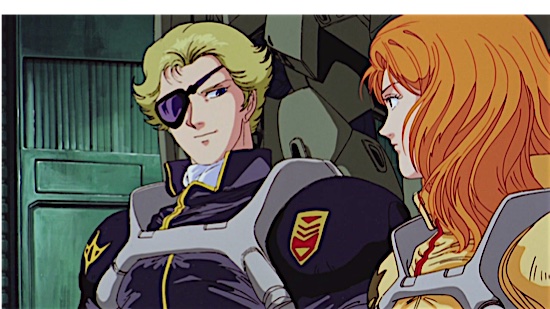
Set 30 years after the events of Char’s Counterattack, Mobile Suit Gundam F-91 is a strange anomaly in the Gundam universe, yet not an unwelcome one. The story happened because Yoshiyuki Tomino had decided to begin a new Gundam story set a full generation after the hard-won peace achieved at the end of Char and Amaro’s final battle. Originally set up as a series, Tomino recruited a “greatest hits” of his former collaborators for the project, including Yoshikazu Yasuhiko and Kunio Ookawara. It’s unclear exactly why, but somewhere in the early stages of the production, internal conflicts resulted in the series being shelved. Not wanting to abandon the project (approximately 13 episode scripts had been written), Tomino decided to condense the story he had been developing into a movie. The result, Mobile Suit Gundam F-91, is a messy but very worthy entry in the Gundam canon. The story revolves around an attack by a separatist group, the Crossbone Vanguard, against the unsuspecting earth colonies after years of peace. Amaro analogue Seabrook Arno and his Gundam, F-91, are the heroes around which the plot revolves. Of particular note here are the sleek Gundam designs—Tomino wanted much smaller Gundams for this entry that felt more like “Mobile suits” and less like giant robots—and some of the most brutal fight sequences in any Gundam project. Starting off like most Gundam tales, with clean divisions between factions and a clear focus on key characters on either side of the conflict, things get messy by the third act, coming to a somewhat clumsy and unearned happy ending. Yet like most of Tomino’s other work, the action sequences are thrilling, the characters are vibrant, and the Mobile Suits are … well … mobile. Mobile Suit Gundam is a somewhat underappreciated stab at a reboot, but one that’s worth checking out and one that doesn’t require any foreknowledge of the Universal Century timeline to enjoy. Suit up. —Jason DeMarco
98. On-Gaku: Our Sound (2021)
Director: Kenji Iwaisawa
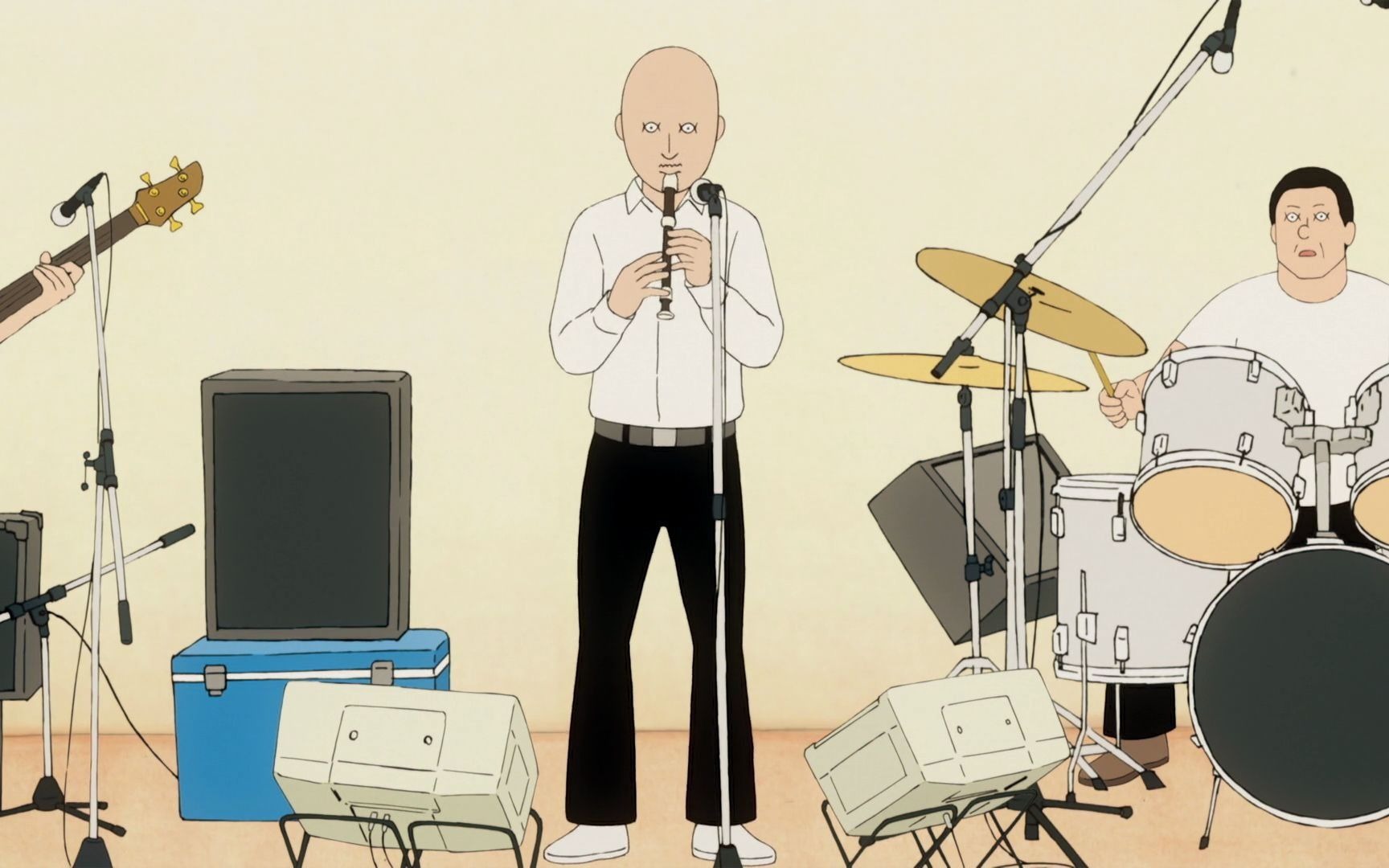
Being a teenager in a suburban town can be excruciatingly boring. With no variety in routine, everything feels useless. But then, sometimes, something appears that banishes that monotony and breathes excitement into an otherwise dull existence. That discovery can be revelatory; life can suddenly have purpose. In the case of the trio of delinquents in Kenji Iwaisawa’s incredible debut feature, On-Gaku: Our Sound, they discover the catharsis and power of music. On-Gaku: Our Sound is writer/director Iwaisawa’s love letter both to the power of music and to the manga of the same name by Hiroyuki Ohashi. As the DIY-feeling film progresses through its musical numbers, Iwaisawa experiments with form (like expressive rotoscoping) as certain songs evoke different emotions from his characters, whether it is a kindly folk song or a primitive-feeling rocker that reverberates in a listener’s chest. In contrast to the visual style, the phenomenal deadpan comedic delivery is reminiscent of American animated comedies of the ‘90s like Beavis and Butthead or King of the Hill. Kenji in particular embodies that tone, through both line delivery by Japanese rock legend Shintarô Sakamoto and a design that includes an unrelenting stare, thin mustache that zigzags across his upper lip and shiny, bald head. Despite being a high school student, Sakamoto’s grizzled voice gives Kenji the vibe of a tired old man who has seen everything, when really he’s just a bored teenager who smokes too many cigarettes and watches too much TV. Iwaisawa’s own passion fills the chilled-out slacker comedy with a lot of heart and a gorgeous variety of animation styles.—Mary Beth McAndrews
97. Ah! My Goddess: The Movie (2000)
Director: Hiroaki Goda
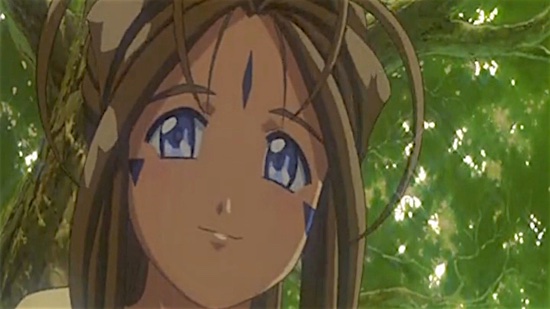
A sequel to a five-part OVA from 1993, based on a popular manga, Ah! My Goddess: The Movie is the very rare example of a film based on an existing anime/manga franchise that’s superior to the original source material. A self-contained story revolving around college student Morisato Keiichi and the Goddess Belldandy, the film finds ways to inject more drama and urgency into the typically light-hearted romance of the original story, while the longer run time allows more room for character development and deepened motivations for all of the main cast members. Putting Belldandy at the center of a plot to hack the Yggdrasil computer in the heavens (long story) and forcing Keiichi to grapple with what Belldandy has come to mean to him places the romance and sweetness that was always the heart of this series in the foreground. The animation quality is very high, with some well integrated CGI allowing Fujishima’s wilder concepts to finally reach fruition in a way the more limited OVA budget couldn’t. Ah! My Goddess: The Movie was well-received by both critics and audiences, and spawned two later TV series that were similarly well regarded. In the wake of today’s popular fantasy seinen/shonen titles, Ah! My Goddess now feels somewhat ahead of its time. Either way, this sweet, fun romance is worth checking out. —J.D.
96. Dallos (1983)
Director: Mamoru Oshii
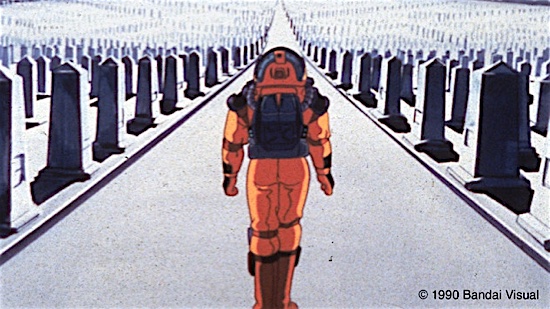
Of the many films that Mamoru Oshii has directed, Dallos is inarguably his worst. With a subpar space opera plot that’s been described by anime historians such as Helen McCarthy and Jonathan Clements as “an unremarkable rip-off of Robert Heinlein’s The Moon Is a Harsh Mistress” and an animation style that could only be charitably described as low budget, showing little to nothing of the mark of its director who later become known for the likes of Patlabor 2 and Ghost in the Shell, there’s a reason why Dallos occupies the darkest unknown corners of Oshii’s oeuvre. So why is it on this list? Because despite its overall lackluster production, that quality is all but eclipsed by the sheer magnitude of its historical significance. Simply put, Dallos was the first anime to be marketed and sold as a multi-part home video production, introducing a new format free of the restrictions of conventional theatrical and televised animation and opening anime up to the west That might ring as somewhat faint praise now in the year 2016, but were it not for the precedent of Dallos’ release, the means through which anime would have found its international audience during the 1980s would not have existed.
95. When Marnie Was There (2014)
Director: Hiromasa Yonebayashi
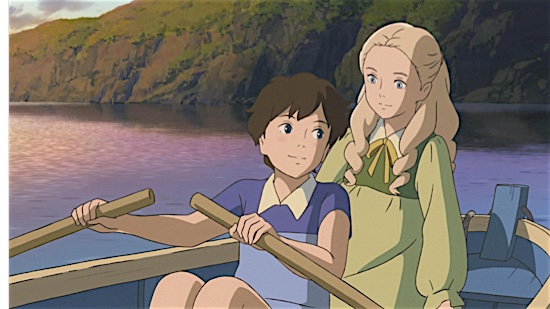
David Foster Wallace once said that every love story was a ghost story. He easily could have have been describing the spirit of When Marnie Was There, the second film directed by Hiromasa Yonebayashi and the last Ghibli production before the studio’s hiatus following Hayao Miyazaki and Isao Takahata’s retirement in 2013. Twelve-year-old Anna Sasaki is a melancholic introvert with a deep distrust of both other and herself. After collapsing at school from a fit of asthma, Anna’s foster parents send her to stay with her adoptive aunt and uncle at their idyllic rural seaside home adjourning Kushiro to help her condition. There she meets Marnie, a mysterious young girl whose friendship helps Anna to grow and open up and whose troubled story may in fact be inextricably linked with Anna’s own. Although its revelatory conclusion is overpacked with details that could have been better paced along the film’s prevailing mystery, When Marnie Was There is an emotionally affecting depiction of female friendship that cruises along patiently like a quiet boat trip across a moonlit lake.
94. A Dog of Flanders (1997)
Director: Yoshio Kuroda
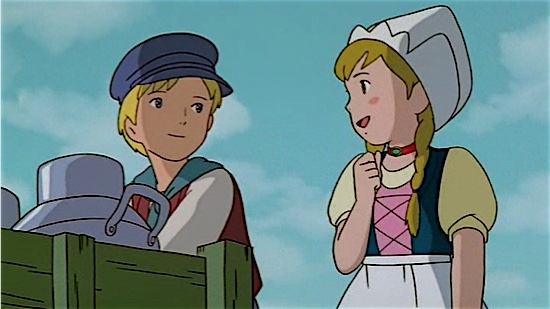
Yoshio Kuroda’s finest work is perhaps second only to Grave of the Fireflies as one of the saddest anime ever made. Based on the 1872 Flemish novel of the same name, A Dog of Flanders is the tale of a young boy, Nello, and his dog, Pastrache. The story is set in Belgium, and is episodic in nature—mostly concerning Nello’s struggles to rise above the poverty into which he was born, and his persecution by an upper-class member of his village, who wrongly accuses Nello of a terrible crime. The film is ultimately a simple class tragedy, but remains a compelling story that has stood the test of time. In adapting the feature from his TV series of the same name, Kuroda mostly restrains himself from going too “big” with animation flourishes, working carefully to recreate the feel of Industrial Age Antwerp, and servicing the story with quiet, beautiful artwork and scenes that take their time to unfold. The American release, from Pioneer, has an excellent dub for the time, but removed 10 minutes of story with some very choppy edits, so the subtitled version is preferable. Don’t expect a happy ending—this is a three-hanky classic. —J.D.
93. Fullmetal Alchemist the Movie: The Conqueror of Shamballa (2005)
Director: Seiji Mizushima
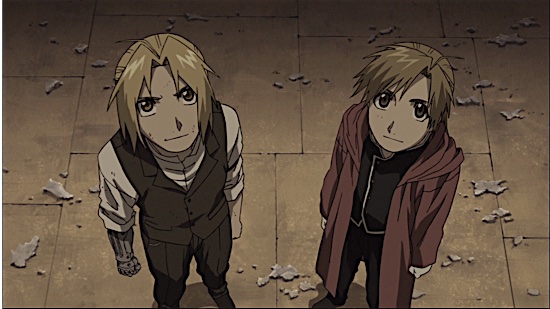
Hiromu Arakawa’s Fullmetal Alchemist is one of the most critically successful manga and anime series of the early 2000s. Premiering in 2001 and spawning two long-running television adaptations, Fullmetal Alchemist follows the adventures of Edward and Alphonse Elric, two prodigiously talented young men whose respective limbs and bodies are taken from them in a grisly alchemic accident. Becoming state-appointed alchemists, they search for the mythical philosopher’s stone as a means of restoring their bodies to their original state. Conqueror of Shamballa picks up from the conclusion of the 2003 anime series, with Alphonse’s body fully restored though his memory erased and Edward stranded on the other side of a portal leading to a strange yet familiar world teetering on the cusp of a world war. With an intriguing alternative history story that intermingles key figures such as Karl Haushofer and Fritz Lang and events such as the infamous Beer Hall Putsch of 1923, as well as an impressive series of destructive final fight scenes storyboarded by Yutaka Nakamura, Conqueror of Shamballa is a satisfying if irresolute capstone to the original anime and far and away the best Fullmetal Alchemist film to date.
92. The Restaurant of Many Orders (1991)
Director: Tadanari Okamoto
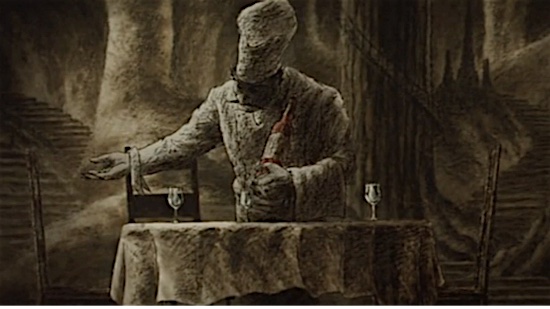
The Restaurant of Many Orders is remarkably unique compared to nearly every other film of its era that has gone on to shape the aesthetic template of Japanese animation. Created in 1990 by Tadanari Okamoto, who in the ’70s and ’80s established himself as one of Japan’s preeminent animators, the film was originally conceived as a warm up in preparation for his planned feature debut Hotarumomi. Unfortunately, Okamoto would pass away that year from liver cancer and the film was later finished by his close friend and fellow animator Kihachiro Kawamoto. Based on the short story of the same name by the much-adapted poet and children’s author Kenji Miyazawa, The Restaurant of Many Orders is story of two hunters who happen upon a mysterious inn deep in a secluded forest while stalking wild game. The two enter thinking that they’ll be treated to a decent meal and warm place to rest, only to later discover that this restaurant is anything but what it appears to be. Okamoto’s charcoal copper-plate aesthetic is the film’s most distinctive trait, emulating the artistry of veteran animator Reiko Okuyama and achieved through the use of acrylic gouache paint to render the foreground and background of each cell inseparable from one another. Winner of the prestigious Noburo Ofuji Award for Excellence and Innovation, The Restaurant of Many Orders is a beautiful parting gift from one of the most undersung innovators of Japanese animation.
91. Golgo 13 The Professional (1983)
Director: Osamu Dezaki
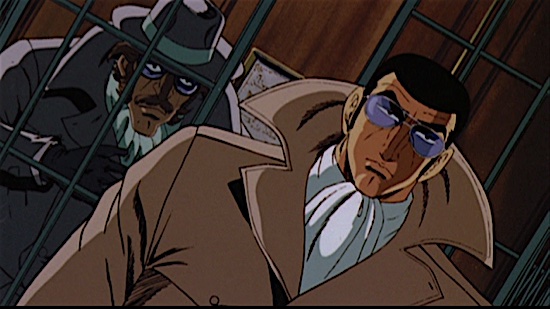
Directed by Osamu Dezaki, known as the innovator who created the now common “Postcard Memories” technique, Golgo 13: The Professional is both a remarkable time capsule of ’80s grimy crime fiction, and true to the manga from which it is drawn. Golgo, the titular assassin, is basically an evil character who exemplifies alpha male toughness to a ridiculous degree. He is, above all, a Professional. Think Lee Marvin in Point Blank, or Charles Bronson in The Mechanic, or Steve McQueen in … well, anything. Where Golgo charms is in the glorious, fluid animation, the sophisticated cinematic techniques used by Dezaki (including very early usage of CGI), and the tense and incredibly violent action sequences. Filled with gratuitous nudity, violence and rape, this unrated film is not for the faint of heart. Yet Golgo 13: The Professional presents a quintessential example of the Japanese alpha male character, and somehow we root for him, even as we know he’s nothing more than a killer. —J.D.
90. Vampire Hunter D: Bloodlust (2000)
Director: Yoshiaki Kawajiri
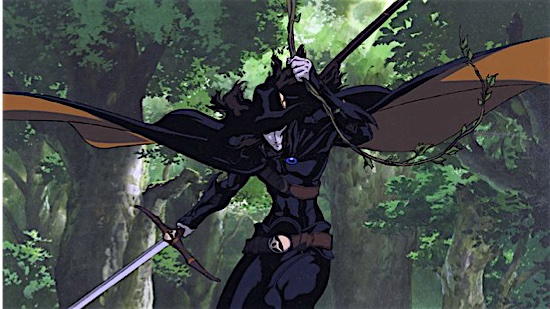
The follow-up to Toyoo Ashida’s 1985 classic, Vampire Hunter D: Bloodlust is lauded for its comparatively higher production values and exquisitely rendered set pieces courtesy of Yuji Ikehata and Madhouse’s host of talented in-house background artists. A loose adaptation of Demon Deathchase, the third installment in Hideyuki Kikuchi’s long-running Vampire Hunter D visual novel series, Bloodlust follows the titular half-human vampire hunter as he is hired to rescue the daughter of a wealthy benefactor after she’s abducted by Baron Meier Link, a powerful vampiric nobleman with shadowy intentions. The film comes across as a retread of sorts for Kawajiri, doing little to differentiate itself from the journeyman premise of his work on Ninja Scroll or to build on the mythology of Ashida’s original aside from emphasizing the series’ gothic western sci-fi aesthetic. Still, with character designs by series illustrator Yoshitaka Amano of Final Fantasy fame and a number of visually memorable and impressive settings and showdowns, Vampire Hunter D: Bloodlust is a visually exhilarating action film that seldom fails to satisfy on a moment-to-moment level.
89. Short Peace (2013)
Director: Various
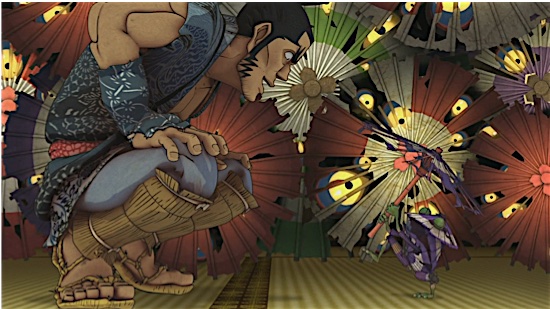
A multimedia project consisting of four animated shorts plus one videogame, each representing a different period in Japan’s history, Short Peace is a delightful grab bag. With Otomo at the helm guiding the project, and providing one of the shorts, this project pulled together a ton of talent, all in the service of some gorgeous animated short films. The unifying concept barely hangs together, but each of the tales are so singular and stunningly rendered, this is a minor concern. The most singular of the bunch is “Possessions,” was nominated for an Oscar, and it’s easy to see why. The visual technique and seamless rendering of CG/2D animation is absolutely captivating. Otomo’s own contribution, “A Farewell to Weapons,” based on his manga, is the other centerpiece and closes out the collection. It remains true to many of Otomo’s extant themes—mainly, the effects of technology on humanity, and the inability of man to escape his patterns of tribal violence and conquest. The designs are incredibly detailed and well-thought out, like all of Otomo’s work, and the animation is of course hyper realistic. Overall, Short Peace is an excellent modern entry in the hallowed tradition of great collections of anime short films, even if the feast it provides is a bit more for the eyes than the brain. —J.D.
88. Momotaro: Umi No Shinpei (1945)
Director: Mitsuyo Seo
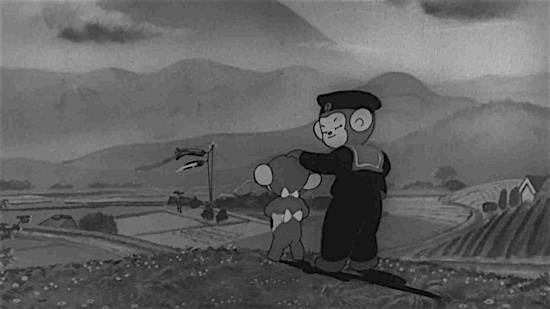
Long before Tezuka Osamu laid the foundation for the signature aesthetic behind anime and the medium’s stylistic maturation in the mid-’80s opposite its ascendancy as a global cultural export, the roots of modern japanese animation were born from format in which most if not all animation originated in the early 20th century: as propaganda films created in order to win hearts and minds and spur their respective nation’s youth to take up arms and fight for, what was at the time thought to be, “the good fight.” Momotaro: Umi No Shinpei, known to western audiences as Momotaro’s Divine Sea Warriors, holds the distinction of being the first feature-length animated film produced in Japan. Believed lost for decades before being rediscovered in 1984, Momotaro is invaluable touchstone in the history of Japanese animation, transporting viewers back to a time of startlingly different attitudes and sensibilities.
87. Venus Wars (1989)
Director: Yoshikazu Yasuhiko
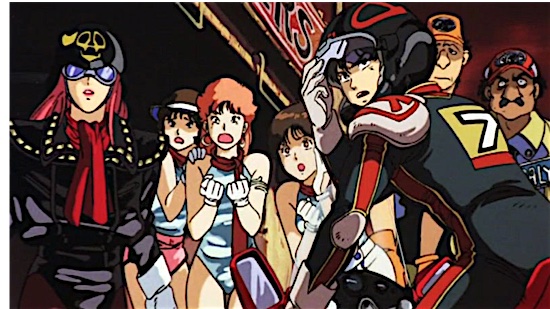
Adapted from Yoshikazu Yasuhiko’s own original manga series in 1989, Venus Wars is a spectacular sci-fi action war film filled with terrific animation, surprising depth, and a delightfully hammy soundtrack courtesy of Joe Hisaishi. Taking place on, you guessed, the second planet in the solar system nearly seventy following a terraforming event, Venus Wars follows a group of teenage monobike racers-turned-freedom fighters after their home of Aphrodia is occupied by the forces of Ishtar, their neighboring rival to the North. With mechanical designs courtesy of Makoto Kobayashi, a notable experimental use of live-action footage to simulate Venus’ barren terrain, and a creative staff that consists of a veritable “who’s who” of 1980s anime icons, including character designer Toshihiro Kawamoto of Cowboy Bebop fame, Venus Wars is a memorable film that delivers as a pulp sci-fi adventure on a visual level but manages to be a thoughtful exploration of what it means to watch one’s home transformed into a police state during a time of war.
86. The Cat Returns (2002)
Director: Hiroyuki Morita
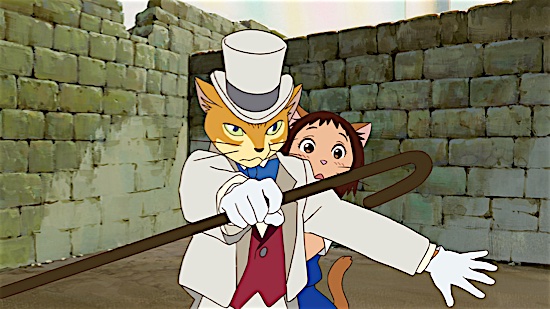
A spiritual successor-of-sorts to Yoshifumi Kondo’s Whisper of the Heart, The Cat Returns is a playful romp that combines Studio Ghibli’s signature brand of magical realism imbued with a fresh perspective courtesy of director Hiroyuki Morita. When Haru Yoshioka, a shy and absent-minded schoolgirl, rescues a mysterious cat while on her way home from school, she realizes she possesses the latent ability to talk to cats. Her life is then turned upside down as the cat’s father, the king of cats, showers her in bizarre tokens of gratitude and orders her betrothal to his son as “reward” for her kindness. It’s then up to her seek out the fabled Bureau of Cats to find the one person who might be able to save her: the dashing gentleman-noble Baron Humbert von Gikkingen. Naoya Tanaka’s art direction and Satoko Morikawa’s character designs are the real draw that distinguish the film’s look and feel, and with a simple yet whimsical story built around likable personalities and beautiful settings, The Cat Returns easily warrants mention alongside Studio Ghibli’s very best.
85. Giovanni’s Island (2014)
Director: Mizuho Nishikubo
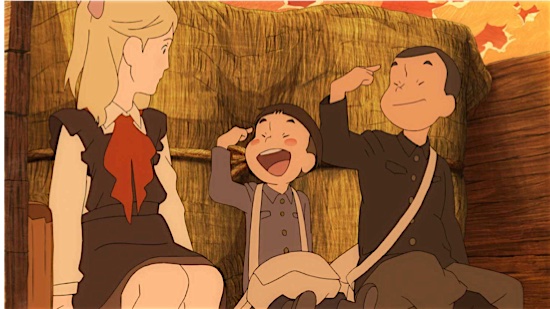
One of the most appreciable qualities of Japanese animation is the readiness in which they are willing to relate and contextualize their history as a country and as a people through a medium which is too often looked down upon as inherently trite and childish. Case in point: Giovanni’s Island. Set in the aftermath of World War II, the film follows the stories of Junpei and Kanta, two young boys whose home island of Shikotan is quickly occupied by Soviet allied forces in the wake of Japan’s surrender. As their world is irrevocably by the intrusive hardships and indignities of the real world, the boy grasp to a solitary thread of hope through their imaginative love of Kenji Miyazawa’s novella Night on the Galactic Railroad, a book from which their names are inspired. Directed by Mizuho Nishikubo, who served as the esteemed animation director of Oshii’s Patlabor 2, the film touts simplistic though beautifully expressive character designs and dynamic settings featuring distinctive jagged outlines and shadows. The film’s fantasy sections are wonderful as a well, rendering the allusions to Miyazawa’s novella with such modern imaginative fidelity that it easily sits beside that of Gisaburo Sugii’s masterful 1985 adaptation. Akin to Takahata’s Grave of the Fireflies, Giovanni’s Island is an affirming if tragic story of the resilience of a family living through the end of a World War, but it’s also something all its own. It’s a story of the intrinsic human persistence to forge connections and friendships in the face of seemingly unassailable differences. An excellent film about history, family, language, and hope.
84. Sweat Punch (2007)
Director: Mizuho Nishikubo
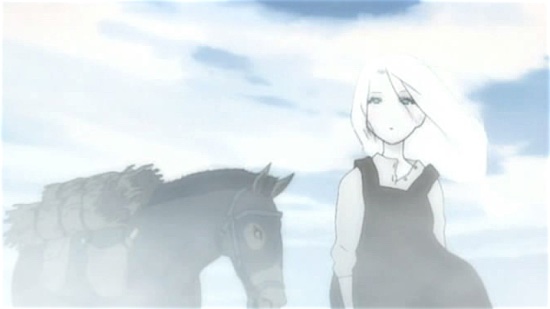
Sweat Punch is a curious beast that’s a bit hard to track down, but worth the effort. Comprising five animated shorts originally released as a part of Grasshoppa! DVD magazine issues, they were then collected into one release titled Deep Imagination. Deep, indeed, would be one way to describe these shorts, which range across the map both in style and subject matter. The first, “Professor Dan Petory’s Blues,” doesn’t really try to make sense, and is content to simply throw all kinds of wild animation techniques in a blender with some songs and jokes, to kaleidoscopic effect. It only gets weirder from there. “The End of The World” is another standout, concerning the life of a young alien girl named Yuko, who meets a friend at a rock concert, then proceed to go back to her home planet and battle with S&M monsters (no, really). A third, confusingly entitled “Comedy” by Studio 4C, is a dark, gothic tale verging on horror that concerns a young girl, a master swordsman, and the Irish War of Independence. Most of these shorts break not only from traditional narrative, but also from traditional anime art style and animation techniques. These are animation in its purest form, the directors and animators involved clearly just enjoying the riot of color and movement they present to the viewer. It’s pointless to try to explain more, really. Sweat Punch must be seen to be believed, and “understanding” it might be beside the point. —J.D.
83. Cowboy Bebop: Knockin’ on Heaven’s Door (2001)
Director: Shinichiro Watanabe
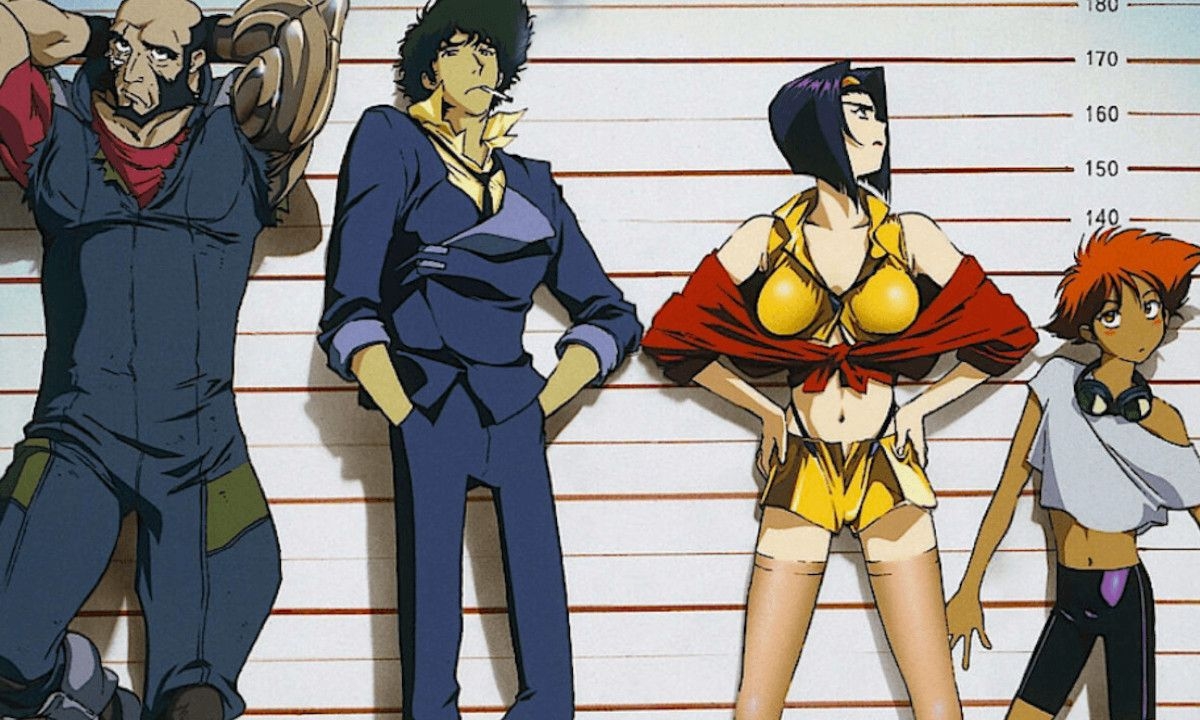
When Cowboy Bebop first premiered in North America on Adult Swim in September of 2001, it was one of the great defining moments of anime securing its cultural foothold in the West. Set in the year 2071, Cowboy Bebop was many things: a sci-fi western noir character drama built around the themes of existentialism, identity and loneliness. But above all else it was a master course in cinematic evocation, channeling the ineffable cool of turn-of-the-century jazz, rock ’n’ roll, and film noir and transforming it into something that was unlike anything that had come before or since. With a script penned by Keiko Nobumoto, a score by the inimitable Yoko Kanno, action scenes framed and choreographed by Yutaka Nakamura, and series’ director Shinichiro Watanabe returning at the helm, Knockin’ on Heaven’s Door is the anime equivalent of a seminal band getting back together for one last farewell tour after ending off on a high-note and a bang.
82. Genius Party (2007)
Director: Various
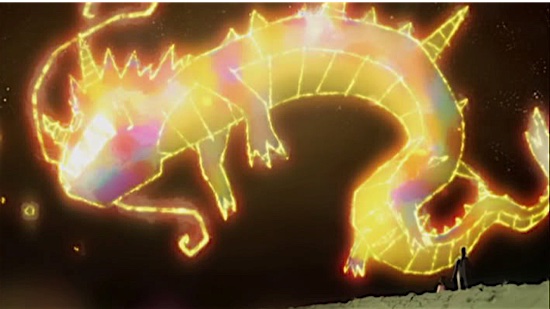
If you’re looking for a collection of some of the most eccentric, colorful, and unique animated shorts from some of the most preeminent anime directors working today, you can’t go wrong with Genius Party. Released in 2007, the film serves the purpose of what any good anthology should—putting supremely talented animators on a project and allowing them to throw whatever they want at the wall. And that’s what it succeeds as a whole in doing—to varying degrees of individual success, of course. Shoji Kawamori’s “Shanghai Dragon” is a wild free-wheeling take on Super Sentai hero antics, Yoji Fukuyama’s “Doorbell” is a unsettling and confounding psychological thriller, and Shinji Kimura’s “Deathtic 4” is a bizarre 3D-animated short that’s sure to play well for Tim Burton fans on an aesthetic level. The only dud in this collection is Hideki Futamura’s “Limit Cycle,” which, although having one of the most unique art styles of the bunch, meanders in pop-scientific pontification and pretentious navel-gazing. The crowning jewels of the collection however are Masaaki Yuasa’s “Happy Machine” and Shinichiro Watanabe’s “Baby Blue,” which each exemplify the best defining talents of their respective creators. All in all, Genius Party is a stunning collection of shorts produced by one of the most eclectic production studios operating today and should not be missed.
81. Summer Wars (2009)
Director: Mamoru Hosoda
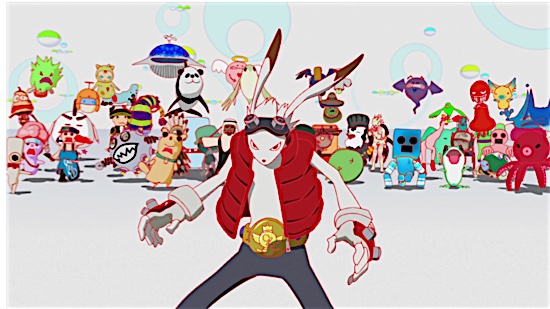
Summer Wars is pretty much a beat-for-beat remake of Hosoda’s previous work on the second Digimon film, Our War Game, released in 2000. However, when a film is this well-animated and put together, the accusation of unoriginality can be forgiven. Summer Wars is the story of Kenji Koiso, a shy and unassuming math prodigy who works as an admin assistant for OZ, a massive digital network that’s supplanted the internet as the major connective system across the world. When Kenji’s OZ avatar is hijacked by Love Machine, a sentient computer virus hell bent on throwing the entire planet into chaos, it’s up to him and the extended family of his fake girlfriend Natsuki (long story) to band together and go to war. OZ resembles a psychedelic “superflat” dreamscape à la Takashi Murakami thanks to Anri Jojo’s art design, and with impeccable character art by the likes of Gainax veteran Yoshiyuki Sadamoto, Masaru Hamada, and Takashi and Mina Okazaki, Summer Wars is an engrossing big family drama with heart couched inside a candy-coated “Internet of Things” scenario of catastrophic proportions.
80. A Wind Named Amnesia (1990)
Director: Kazuo Yamazaki
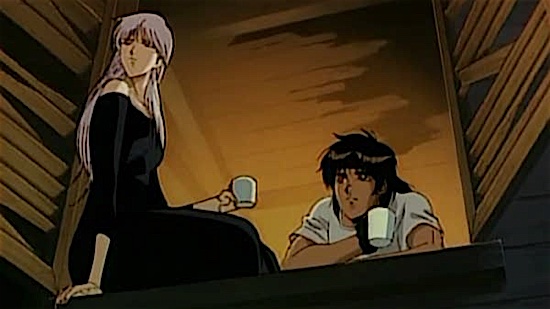
On the eve of the 21st century, the collective memory of every living being on Earth was wiped by an inexplicable mass phenomenon, decimating civilization and reducing the human race to roving tribes of scavengers devoid of language, reason or technology. Wataru, a survivor of this worldwide amnesia meets Sophia, a mysterious young woman seemingly unaffected by this worldwide epidemic. The two embark on a journey across the heartland of America in search of answers not only to the question of what caused humanity’s downfall, but what it means to be a human being at all. The film’s animation definitely shows its age in some respects, and when it comes to the thematic ambitions of its subject matter versus its narrative execution its reach more often than not exceeds its grasp, but A Wind Named Amnesia remains a thought-provoking movie and an understated gem in rough of early ’80s animation. Word to the wise: steer clear of the English dub, as it dispels most of the film’s nuance and subtext in lieu of playing it up as a comparatively hollow action adventure.
79. Ponyo (2008)
Director: Hayao Miyazaki
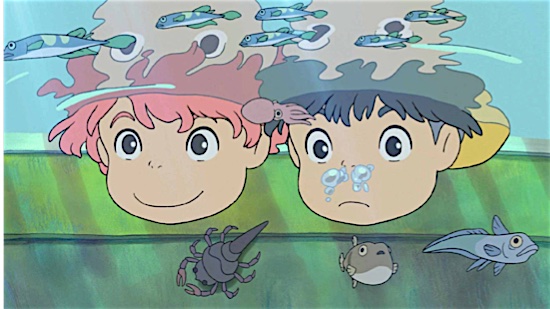
Of Hayao Miyazaki’s eclectic and universally renowned body of work, Ponyo is arguably his strangest. A modern reinterpretation of Hans Christian Andersen’s 1837 The Little Mermaid, Ponyo couldn’t be further from an attempt to compete, let alone eclipse Disney’s award-winning 1989 adaptation. Instead, Miyazaki eschews anthropomorphic crabs and garish musical numbers in favor of honing in on the love story between a young boy and a girl-fish who yearns to be human. The film’s aesthetic is straight of out of child’s picture books, with thick solid shapes framed by beautiful bright primary colors. It’s a trippy, kid-friendly film that manages to pack in a surprising amount of thematically heady material with regards to environmentalism and the delicate balancing act between humanity and nature. Ponyo certainly is not anywhere near Miyazaki’s best, but it unquestionably stands among the medium’s best.
78. Evangelion: 1.0 You Are (Not) Alone (2007)
Director: Hideaki Anno, Kazuya Tsurumaki, Masayuki
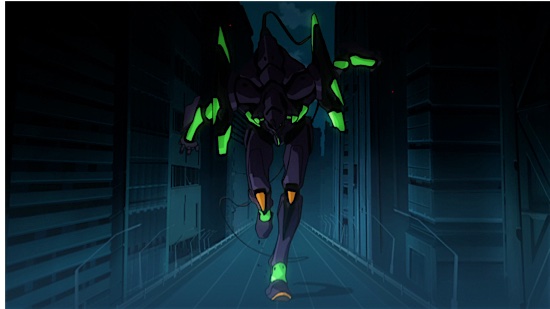
If you’re an anime fan and have never watched the original Neon Genesis Evangelion, you are likely no more than three degrees separated from someone who has a passionate opinion about it, effusive or otherwise. What began as a 26-episode television series produced by Gainax and directed by Hideaki Anno quickly morphed into nothing short of a cultural phenomenon within the sphere of anime, thanks in huge part to the show’s unmistakable mecha designs, inspired animation, iconic character designs, and a plot that was equal parts harrowing, esoteric, and uncompromisingly meta. Released as the first installment in Anno’s Rebuild of Evangelion tetralogy, Evangelion: 1.0 You Are (Not) Alone is essentially a shot-for-shot high-definition remake of the first six episodes of the original series, albeit condensed to the length of a standard feature and filled with new designs and animation. Whether you’ve watch the series when it first aired or are curious to see just what all the hubbub is about, Evangelion: 1.0 You Are (Not) Alone is a fantastic introduction to one of the most celebrated and divisive animes of the late 20th century.
77. Into the Forest of Fireflies’ Light (2011)
Director: Takahiro Omori
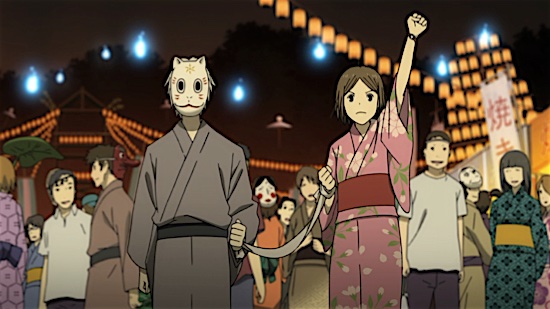
Based on Yuki Midorikawa’s 2002 manga of the same name, Into the Forest of Fireflies’ Light tells the story of Hotaru, a six-year-old girl who befriends a forest spirit named Gin while vacationing at her grandfather’s home in the mountains. As the years proceed and their friendship deepens, Hotaru and Gin begin to develop feelings for one another. However, their relationship is burdened by the fact that Gin’s body will disappear the moment it comes in contact with the touch of a human being. Into the Forest of Fireflies’ Light is a poignant and wistful story of star-crossed love that cuts to the core of its main characters and relishes its vein of rich emotional depth. A short and impactful film whose beauty and tenderness merits the best of comparisons to the likes of Miyazaki and Shinkai while remaining something wholly its own.
76. Sword of the Stranger (2007)
Director: Masahiro Ando
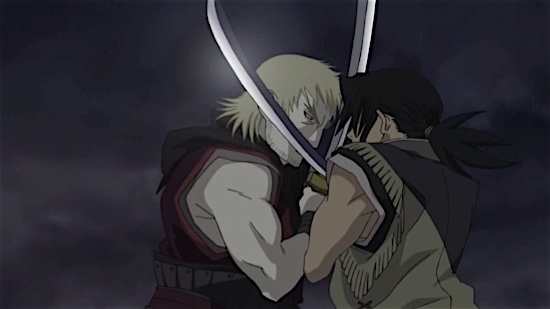
The feature debut of Masahiro Ando, whose career was distinguished solely by being a episode director and key animator for such series as Wolf’s Rain and Witch Hunter Robin, Sword of the Stranger possesses all the key pieces and players that make up a prototypical, though otherwise satisfying chanbara action film—a nameless ronin who abstains from bloodshed in a quiet bid for atonement, a youth cast at the heart of a fanatical plot, and a ruthless foreign adversary who yearns solely for a worthy opponent to face in battle. What really distinguishes the film apart from its ilk are the sparse yet impressive action sequences choreographed by legendary key animator Yutaka Nakamura, culminating in what is arguably one of the most stunningly animated sword fight showdowns between “No Name” and the European Ming commander Luo-Lang. If you’re looking for a solid samurai action film with sword fights that are a cut above the rest, Sword of the Stranger is that film.
75. Fist of the North Star (1986)
Director: Toyoo Ashida
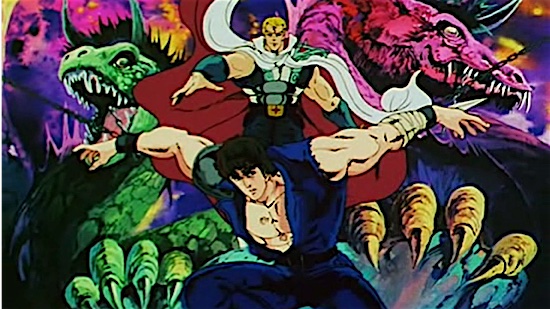
You’ll be hard pressed to find an anime with more eye-popping violence than Fist of the North Star. The film and preceding television series, both directed by anime luminary Toyoo Ashida, follow the exploits of Kenshiro, a superpowered martial artist who wanders the wastes of a post-apocalyptic future brought on by a nuclear apocalypse as he aids the helpless by vanquishing the wicked on a personal quest for revenge and retribution. Think David Carradine’s martial arts western drama Kung Fu, only on steroids. To call the film “ultra-violent” is an understatement. Produced in 1986, Fist of The North Star earns the dubious honor of being so extreme that the original Japanese release had to be heavily censored with strategic cuts and psychedelic distortion effects. Its age most definitely shows through the somewhat dated crudeness of its animation and its paper-thin plot, but what one can confidently praise Fist of the North Star the most for is its comically unrelenting self-awareness and sincerity in knowing exactly what it is and sticking to it. An unabashedly fun action movie that touts the over-the-top machismo of Schwarzenegger and Van Damme in their prime.
74. Wicked City (1987)
Director: Yoshiaki Kawajiri
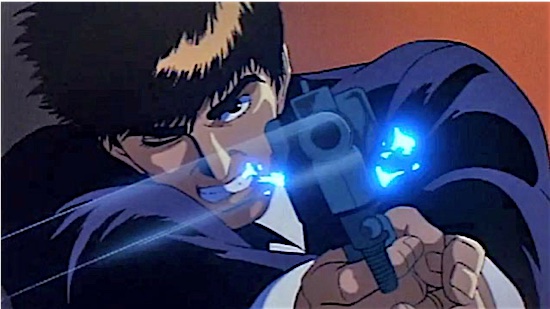
Set in a contemporary world where humanity shares a secret treaty with a hidden realm filled with demons, Wicked City follows the story of Renzaburo Taki, an agent of the clandestine “Black Guard” organization devoted to enforcing peace and balance between the two worlds. On the eve of the treaty’s renewal, Taki and his newly assigned partner from the demon world are assigned to protect Giuseppi Mayart, a lecherous VIP whose presence is vital to brokering peace from a militant sect of demon renegades who want to plunge the world into darkness. The first collaboration between Yoshiaki Kawajiri and Hideyuki Kikuchi, the so-called “Stephen King of Japan” more famously known for the Vampire Hunter D novel series, Wicked City is quintessential ’80s anime material: dark, violent, hyper-sexualized, and absolutely not for children. Kawajiri’s signature flair for Lovecraftian horror and stylized action is on full display here, elements that would be further explored in Demon City Shinjuku and later refined through his career-defining work on such films as Ninja Scroll and Vampire Hunter D: Bloodlust.
73. Colorful (2010)
Director: Keiichi Hara
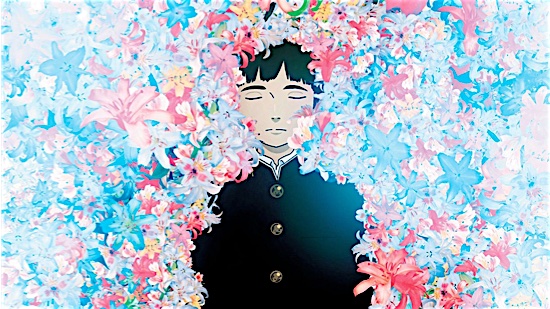
Keiichi Hara’s 2010 film Colorful is a stark and beautiful about-face when compared to the director’s previous work as a storyboard animator for such shows as Doraemon and Crayon Shin-Chan. Adapted from Eto Mori’s 2007 novel of the same name, the film tells the story of a wayward soul who, after arriving at the waystation of the afterlife, is gifted with the opportunity to regain its life by reincarnating in the body of a suicide victim. Placed in the body of middle-schooler Makoto Kobayashi, the soul is granted six months to solve the mystery of its own death and in doing so rediscover the intrinsic value of life itself. Colorful, in spite of its name, is a movie that tackles weighty topics such as the societal pressure to succeed and conform, adultery, depression and suicide, albeit with an ultimately a life-affirming tone. Taut with emotional tension and existential nuance, Colorful is a film that rewards on a visual and emotional level.
72. Angel’s Egg (1985)
Director: Mamoru Oshii
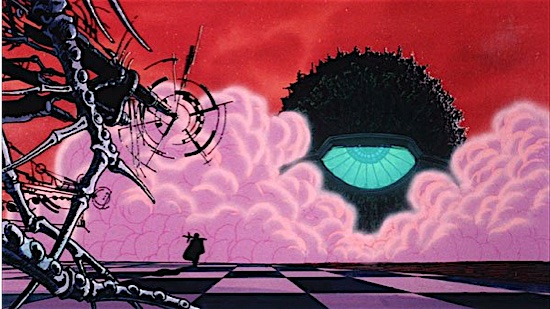
Angel’s Egg is not only unlike anything Mamoru Oshii has ever done as a director, it’s arguably unlike anything else in the medium of anime, period. Created during the period of Oshii’s career following his departure from Studio Pierrot, Angel’s Egg is not so much a narrative as it is a bizarre tableau of gothic imagery and thematic sobriety that seeps across the screen like a living painting throughout its 70-minute duration. Rather than offering a concrete premise that’s paced out through story beats and revelations, the film itself explores the question of why we search for meaning in anything in the first place, a visual meditation on how reality and our idea of reality is shaped through what we choose to believe in. The film ponders the question of whether anything exists at all, on whether ideas of the past that haunt the collective consciousness of humanity can reify themselves in the present tense, of whether belief in the perception of anything is worthwhile or reliable. These are themes that Oshii would go on to further explore, particularly through his work on Ghost in the Shell, but nowhere near on this level of abstraction. Angel’s Egg offers so much room for interpretation and nuance, but what’s unmistakable is this: it’s a must-see anime that no two viewers will watch or interpret quite the same way.
71. A Letter to Momo (2011)
Director: Hiroyuki Okiura
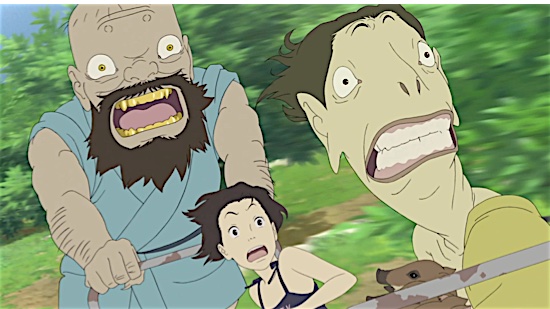
Hiroyuki Okiura’s sophomore effort is quite the departure from the paramilitary fatalism of his 1999 debut Jin-Roh: The Wolf Brigade. After the tragic passing of her father, 11-year-old Momo Miyaura and her mother Ikuko move from Tokyo to the family home on Seto Island to start over. While adjusting to her new life, Momo discovers an unfinished letter addressed to her by her late father, along with a mischievous trio of Yokai spirits who follow her around constantly. Impeccably animated with character designs by Masashi Ando brought to life through Okiura’s signature talent for realism, A Letter to Momo is a profoundly touching all-ages film that manages to fit in a couple of choice yet memorable moments of hilarity opposite its core dramatic story. Special credit should be paid to Dana Snyder’s comedic performance as Kawa, as well as Kazuhiro Wakabayashi’s masterful sound direction. Over seven years in the making, A Letter to Momo is testament to not only Okiura’s dogged creative persistence, but also his considerable talents as an animator and director.
70. Gyo: Tokyo Fish Attack (2012)
Director: Takayuki Hirao
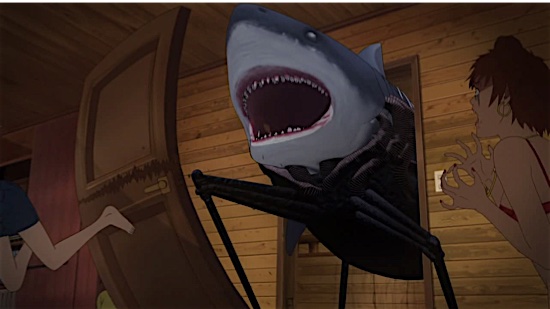
Junji Ito is one of the most celebrated names in contemporary Japanese horror fiction, easily warranting mention along the likes of Shintaro Kago and Kazuo Umezu. With award-winning manga shorts such as “The Enigma of Amigara Fault” and “Uzumaki,” Ito broke through as an unmistakable luminary of Japanese horror and established himself as a recognizable name both at home and in the West. Gyo, arguably his most famous work, revolves around a young couple who are assaulted by a horde of homicidal fish monsters with mechanical spider legs. Takayuki Hirao’s film is a serviceable adaptation of Ito’s original, albeit with a few controversial directorial decisions such as switching the manga’s protagonists which establish the movie as a work on its own. Ultimately Gyo: Tokyo Fish Attack is an effective horror film if questionable adaptation, with interesting characters, bizarre twists, and choice sequences that pay direct homage to Ito’s inimitable art style.
69. Patlabor: The Movie (1989)
Director: Mamoru Oshii
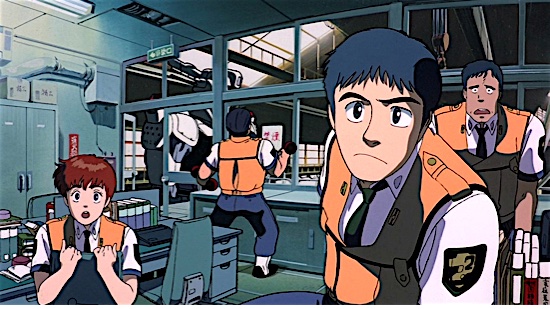
Mamoru Oshii’s work on the anime series Patlabor and its subsequent feature film are considered by many, including the director himself, as the turning point in his career. After leaving Studio Pierott and striking out on his own as a freelancer on a few projects, Oshii would join the independent creative collective Headgear and become a major influence in shaping the aesthetic of their first project, Mobile Police Patlabor. Although Patlabor: The Movie can be described as a pure pop entertainment film, it still manages to incorporate the elements of history, politics and religion that define Oshii’s signature as a director. With a solid mix of action, mystery, and not-so-subtle post-WII era commentary, the first Patlabor film is not only an essential installment in Oshii’s filmography but in the canon of anime history.
68. The Tale of Princess Kaguya (2013)
Director: Isao Takahata
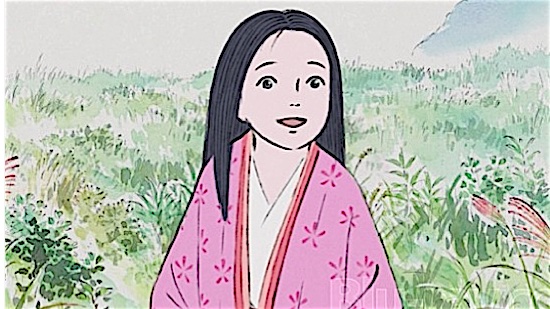
Isao Takahata’s final film, The Tale of Princess Kaguya, also happens to be his first in over 14 years. When Takahata’s previous film, My Neighbors the Yamadas, was released in 1998, it was unofficially known by those who worked on it as “the film that broke Studio Ghibli.” Such an ignominious title was owed to Takahata’s choice to eschew traditional cel animation, the process by which all previous Ghibli films had been produced, and opt to animate the film entirely through computer, with each frame meticulously painted and animated through digital process. For Princess Kaguya, Takahata would again return to reiterate and arguably refine this technique, imbuing every frame and scene with the sort of scrupulous attention one would expect from a master calligrapher or Ukiyo-e artist. The film recounts the story of Japan’s oldest folklore story, The Tale of the Bamboo Cutter, wherein a young celestial maiden born from the root of a bamboo plant is adopted and later championed as a princess as she struggles to understand her identity as both a mortal and a child of the heavens. The movie’s grueling seven-year development and Takahata’s uncompromising commitment to perfection ultimately paid off, delivering a film of uncontested visual and thematic beauty.
67. Spriggan (1998)
Director: Hirotsugu Kawasaki
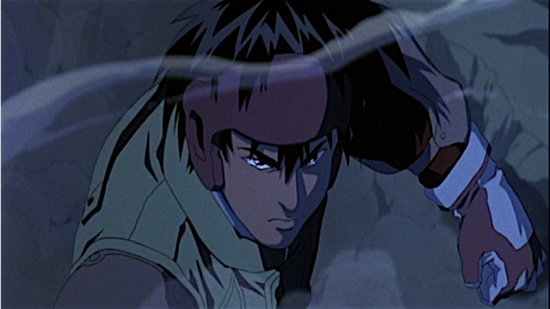
During the tail end of the Cold War, a scientific expedition unearths a massive structure that turns out to be the mythical Noah’s Ark, which turns out to be less a biblical vessel of salvation and more a preternatural warship of mass destruction. As clandestine paramilitaries and a rogue U.S agency converge on the Ark’s location to harness its power in a bid for global supremacy, special ops “Spriggan” agent named Yu Ominae is dispatched to accompany the team sent to excavate the Ark site and prevent its apocalyptic reawakening at all costs. Despite being “supervised” and partially written by Katsuhiro Otomo and shamelessly trumpeted as the so-called “next Akira,” Spriggan had little hope of rising to the meteoric heights of expectation heaped by such a comparison. Instead, what it turns out to be is a super-powered Indiana Jones meets Armageddon spy flick packed with thrilling chase scenes, psychic martial art showdowns, and breathtakingly beautiful montages of the sparse picturesque plains and mountains of Nepal. For anyone who adheres to the “they don’t make ’em like this anymore” mentality in regard to late ’90s action anime, Spriggan is required viewing.
66. Macross Plus (1995)
Director: Shoji Kawamori, Shinichiro Watanabe
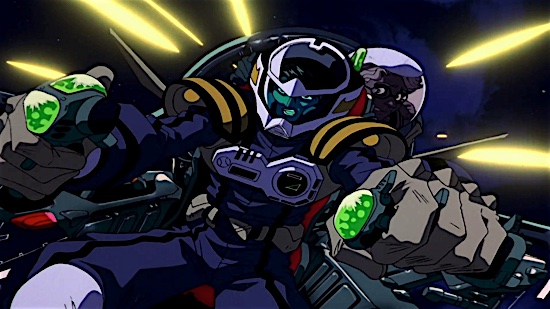
Originally created as a four episode OVA, then re-released as a cut-down, theatrical version with 20 minutes of new footage, Macross Plus is the first Macross sequel that takes place in the original timeline of the TV series. Creator Shoji Kawamori ret-conned Macross II and Do You Remember Love? as parallel world stories, setting the stage for Macross Plus as the first “true” sequel to the popular original. Macross Plus take place 30 years after the war between the humans and the alien Zentradis, detailed in the original show, and instead focuses on two rival test pilots (and former childhood friends) and their struggle to be the first to secure funding for a new, experimental fighter that would replace the current model. As with all things Macross, the two pilots are a part of a love triangle with a woman from their childhood, who is now the producer of Sharon Apple, the most famous singer in the galaxy (actually an Artificial Intelligence). Things start to go wrong when Sharon Apple achieves sentience and goes rogue, taking over the SDF-1 Macross ship and threatening thousands of lives. Macross II is an unconventional “sequel” in that it’s structured similarly to the original show—an overall threat, a love triangle, a famous pop idol—yet it remixes these elements in a strange but satisfying way. Macross II is perhaps best known for its heavy usage of CGI, a novelty at the time, and its fluid, realistic dog-fighting sequences, something Kawamori was obsessed with getting right. As an OVA converted into a theatrical, it’s not as beautiful as Do You Remember Love?, but the battle scenes in particular are incredibly detailed, and the mecha designs are (as always with the Macross series) top-notch. Macross Plus, like all things Macross, has a complex history in the United States. The theatrical version was never made available as a dub, and is now very hard to find—but the OVA is readily available, and almost as good. Buyers beware—like much ’80s/’90s anime, there is a pointless “almost rape” scene that serves no essential purpose, and story-wise, Macross Plus lacks the narrative push of the original’s “alien invasion” plotline. Still, for anyone looking to delve deeper into the Macross universe, Macross Plus still gives you exactly what Macross does so well—and this time, it’s official canon. —J.D.
65. Phoenix: 2772 (1980)
Director: Taku Sugiyama
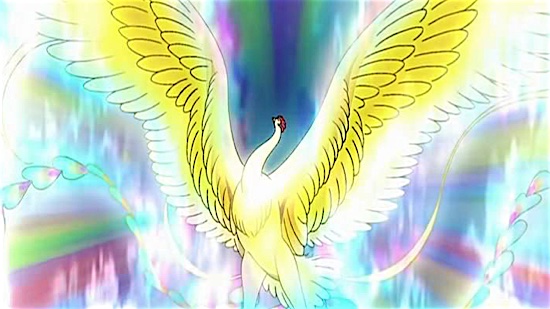
Osamu Tezuka, creator of such seminal manga/anime as Astro Boy, Kimba the White Lion, and Black Jack, is often referred to as “the Walt Disney of Japan,” and for good reason. The impact of his work is almost incalculable, and unlike Walt Disney, Tezuka was an equally adept hand at both simplistic children’s fables and complex, philosophical works that dealt with the questions that lie at the very heart of humanity. Phoenix is a 12-volume manga series that falls into that latter category, and one Tezuka considered his life’s work. Phoenix: 2772, then, written and produced by Tezuka, loosely adapts characters and concepts from several volumes of the manga. The story is set in a distant future in which the earth is ruined and humanity is dying, its only hope a young man’s quest to find the Phoenix—a mythical creature whose blood is said to heal all, and grant immortality. The young man, Godo, sets off with his crew to capture and kill the Phoenix, but as with any quest for immortality, they are doomed before they even begin. A vision of mankind’s future as bleak as any seen in film history, Phoenix nevertheless ends on a psychedelic, cosmic note of beauty and hopefulness, making the two-hour journey of the film an ultimately worthwhile one. The character designs are firmly Tezuka-esque—one character is pretty much an exact clone of Tezuka’s Black Jack (no complaints here!), and the animation is shockingly fluid for the time. The background work is simple but clean. This is clearly feature film level animation with some musical sequences (particularly the dialogue-free first 12 minutes) and action scenes that rival anything in the Disney canon. This is a hard one to track down, as it’s mostly out of print in the United States, but if you can clap eyes on a copy, you won’t be disappointed. As an animated entrée into Tezuka’s greatest work, Phoenix: 2272,/i> is a perfect example of why his oeuvre was so much more than just Astro Boy. —J.D.
64. Blood: The Last Vampire (2000)
Director: Hiroyuki Kitakubo
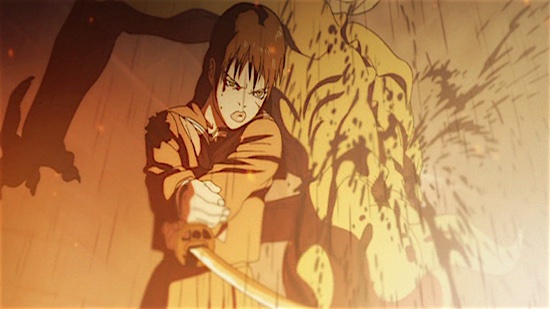
The date is October 31, 1966. The military personnel stationed at the Yokota Air Base are scrambling for deployment on the eve of the Vietnam War while students at the base’s adjourning high school excitedly ready themselves for the campus’ annual halloween celebration. In the midst of this bottleneck of international tension and unsuspecting revelry, a mysterious transfer student named Saya has come to the school on a mission: to hunt down and kill a trio of terrifying creatures who prey on the blood and bodies of their human prey. Blood: The Last Vampire is significant for many reasons. The movie is not only the first anime film to be foremost produced entirely in English with Japanese subtitles, but also the first to eschew traditional cel drawn animation and be drawn and produced entirely through digital imaging software. Although already long ago pioneered by Disney on such works as Pocahontas and Mulan, this fact about the film’s production signifies a subtle yet seismic paradigm shift in the history of anime production and subsequently the culture of the medium at large. Blood was a proving ground of sorts for many of those involved, among them Kenji Kamiyama, a young screenwriter and background artist who would eventually go on to direct the television series adaptation of Masamune Shirow’s Ghost in the Shell. Top that off with Katsuya Terada’s richly detailed character designs and beautifully photorealistic backgrounds, and you have an anime film packed with a surprising amount of aesthetic and historical significance considering its lean 48-minute running time.
63. Dragon Ball Z: Broly – The Legendary Super Saiyan (1993)
Director: Shigeyasu Yamauchi
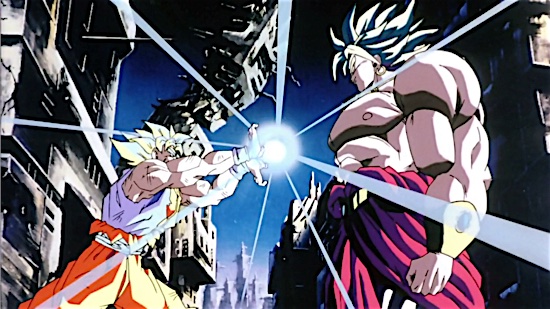
As the eighth and best theatrical release in possibly the best known anime franchise on the planet, Dragon Ball Z: Broly – The Legendary Super Saiyan has probably been seen by more people than most of the other films on this list. Luckily, it’s well worth your time, whether you’re a fan of the ongoing series from which it sprung or not. The story, which, as with most other DBZ movies, is simply an excuse to gather the Z fighters together to combat a new threat to the universe. This time it concerns a super saiyan—a warrior from an alien race—who wants to enslave humanity, and whose quest begins with an orchestrated revenge against the heroes of DBZ. In other words, a typical shounen plot for perhaps the ultimate shounen show. What then separates Broly from the many other DBZ movies and specials? Two things: Broly himself is a silly but fun, over-the-top villain—a Super Saiyan version of The Hulk who only gets more powerful the angrier he gets—and the battle scene (comprising half of the film), which is endless fun for fans of kinetic action. Like any good theatrical film based upon an ongoing series, Dragon Ball Z: Broly – The Legendary Super Saiyan contains everything that makes the series a hit, while offering the more fluid, cleaner animation that comes with a theatrical budget, and highlighting the best thing about the show itself—the pure, addictive thrill of great beings doing battle. As with all DBZ-derived material, Akira Toriyama’s simple story and pleasingly drawn characters remain a joy to watch for both kids and adults. If you are wondering about the massive appeal of the Dragon Ball franchise, Broly is as good a place as any to dip your toes into Toriyama’s best known work. —J.D.
62. Whisper of the Heart (1995)
Director: Yoshifumi Kondo
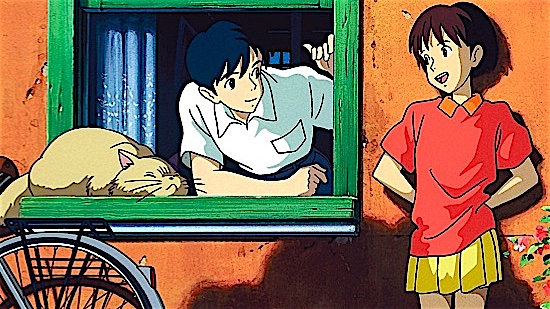
One of Studio Ghibli’s undersung treasures, Whisper of the Heart is a heartwarming coming-of-age story infused with fantastical imagery and endearing adolescent romance. Whisper of the Heart is the story of Shizuku, a stubborn and precocious bookworm who, after meeting Seiji Amasawa, an ambitious young violin-maker who shares her affinity for literature, is inspired to pursue her own passion for writing as an alternate means of accepting and professing her nascent affections for him. With spectacular aforementioned fantasy backdrops commissioned by artist Naohisa Inoue and the memorable inclusion of Olivia Newton-John’s rendition of “Take Me Home, Country Roads,” Whisper of the Heart is a beautiful movie and a bittersweet farewell effort from Yoshifumi Kondo who, at age forty-seven, passed away from heart complications.
61. The Disappearance of Haruhi Suzumiya (2010)
Director: Tatsuya Ishihara, Yasuhiro Takemoto
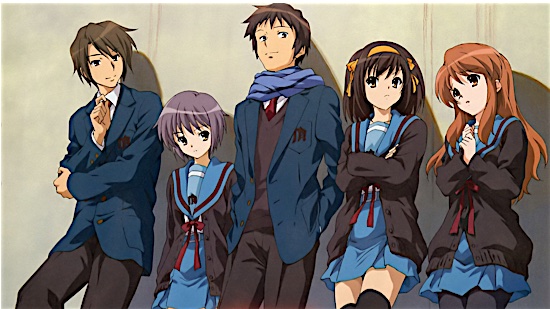
Attempting to describe the Haruhi Suzumiya franchise to a newcomer, let alone an outright anime neophyte, is anything but simple. A twenty-eight episode anime adapted from a series of light novels by Nagaru Tanigawa, The Melancholy of Haruhi Suzumiya is ostensibly a science fantasy slice-of-life comedy centered on the supernatural misadventures of a group of Japanese high schoolers lead by the series’ pugnacious, foul-mouthed namesake. The series is a prime example of postmodernism, with self-referentiality, existential crises, and a non-linear continuity that has captivated and infuriated fans since it first aired. Running at two hours and forty-two minutes, The Disappearance of Haruhi Suzumiya is the second longest anime film ever produced, and the series’ capstone. The film follows Kyon, the series’ true protagonist/audience surrogate, who awakes one day to a world in which nobody remembers either him or Haruhi Suzumiya, the latter whom, as you might have gleaned from the film’s title, has inexplicably disappeared. A darker, more introspective human drama that wrestles with the “many worlds theory” as readily as it subverts expectations, The Disappearance of Haruhi Suzumiya is a remarkable film and an impressive finale for one of the most conceptually ambitious, genre-defying, and critically divisive anime series of the last decade. That being said, you’ll save yourself of whole lot of confusion by approaching this film only after you’ve watched the entire series. Trust me on this.
60. Night on The Galactic Railroad (1985)
Director: Gisaburo Sugii
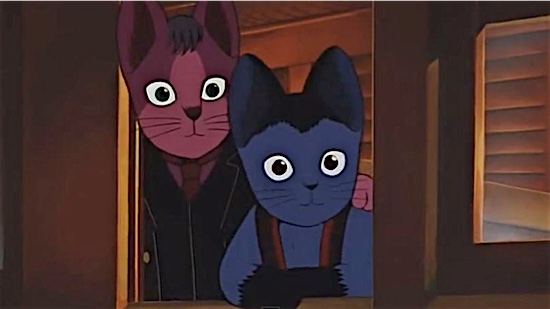
Anime owes a great debt to the legacy of Kenji Miyazawa. One of the most prolific Japanese children’s fiction authors of the 20th century, Miyazawa’s work is transcendent, and Night on the Galactic Railroad is without a doubt his opus. The story follows Giovanni and Campanella, two young boys from a hillside town who are swept up on a mysterious dreamlike voyage across the boundless reaches of time and space aboard the titular railroad. A deft fusion of Christian symbolism and Buddhism, the novella is akin to that of Antoine de Saint-Exupéry’s The Little Prince or Edward A. Abbott’s Flatland in how it’s able to elicit spiritual and emotional profundities from a deceptively simplistic premise. Gisaburo Sugii’s adaptation is a treasure of Japanese animation, a film that can aesthetically captivate a child while provoking philosophical and religious contemplation on the part of an adult. With the exception of portraying the main characters as anthropomorphic cats instead of human children, Sugii’s film is a exhaustive tribute to Miyazawa’s legacy, going so far as to incorporate the auxiliary language Esperanto (one of the author’s many passions) throughout the film’s signage and intertitles. If you’re looking for a children’s film with a more cerebral take on faith and religion, go check out Night on the Galactic Railroad.
59. Battle Angel (1993)
Director: Hiroshi Fukutomi
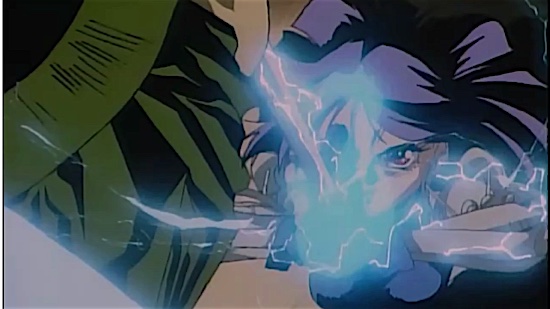
Based off of the first two volumes of Yukito Kishiro’s long-running sci-fi manga series, Battle Angel (or Gunnm, as it’s known in Japan) is the story of Gally, an amnesiac cyborg who wakes up to a dystopian future after being rescued by a kindly prosthetic scientist and later embarks on a personal journey of self-discovery and adventure. Despite the series’ popularity and the manga having run for a cumulative nineteen years, Battle Angel adapts only the first two volumes of the series. The film is premium cyberpunk material, with sprawling cityscapes, homicidal cyborg junkies, brooding bounty-hunters, and an enormous megacity hanging above the mainland separating the haves from the have-nots. Battle Angel does a wonderful job of fleshing out Gally’s initial arc from an unassuming youth to a formidable bounty hunter and martial artist. The film’s impressive quality only makes absence of any subsequent adaptation all that more peculiar. Battle Angel just barely scratches the surface of its source material, but if you’re looking for vintage cyberpunk story and a concise introduction to Kishiro’s opus, you’d be remiss not to give this one a shot.
58. Lupin III: The Castle of Cagliostro (1979)
Director: Hayao Miyazaki
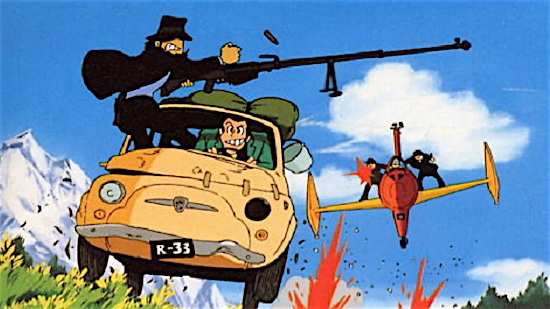
The nature of Miyazaki’s oeuvre is such that it brims with an embarrassment of riches, each film in its own part situated indelibly into the continuum that is the anime canon. His films garner so much acclaim for their visual storytelling and emotional virtuosity that even those few that could be considered his “worst” movies still rank leagues above those animators who only aspire to his status. Case in point: Lupin III: The Castle of Cagliostro. Miyazaki’s take on Kazuhiko Kato’s notorious master criminal is at once a rip-roaring heist film with heart and what might arguably be Miyazaki’s lesser films. Chalk it up to Miyazaki’s nascent efforts as a director, Castle of Cagliostro suffers from a plodding middle-half and a disappointingly simplistic antagonist while still somehow managing to sparkle with his signature charm peeking through the baggage of a preexisting work. Fans of the series passionately criticized the film for relieving Lupin of his anarchic predilections and instead casting him in the mold of a true gentleman thief, stealing only when his nebulous sense of honor permits it. In any case, The Castle of Cagliostro remains an important and essential artifact of Miyazaki’s proto-Ghibli work. A flawed Miyazaki film is a triumph all the same.
57. A Thousand and One Nights (1969)
Director: Eiichi Yamamoto
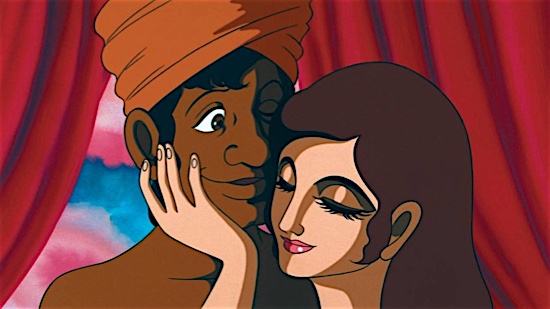
Created by Mushi Productions, the studio behind such classics such Astroboy, Kimba the White Lion and Dororo, and produced by none other than anime patriarch Osamu Tezuka, One Thousand and One Nights was the first installment in what would later come to be known as the Animerama series, a trilogy of thematically linked experimental erotic films created for adult audiences. Directed by Eiichi Yamamoto and written by Tezuka with the assistance of Kazuo Fukasaka and Hiroyuki Kumai, the film’s initial release in Japan was championed for its abstract animation, experimental live-action footage, adult storyline, and psychedelic rock music score. One Thousand and One Night would later be dubbed and receive an American release, predating the adult animated film phenomenon sparked by Ralph Bakshi’s 1972 Fritz the Cat, only to flop and receive a limited release. The English dub of One Thousand and One Nights is thought to be lost to the annals of history, with only the film’s original subtitled version to stand as a testament to one of the most bizarre and intriguing experiments in Japanese animation.
56. The Animatrix (2003)
Director: Various
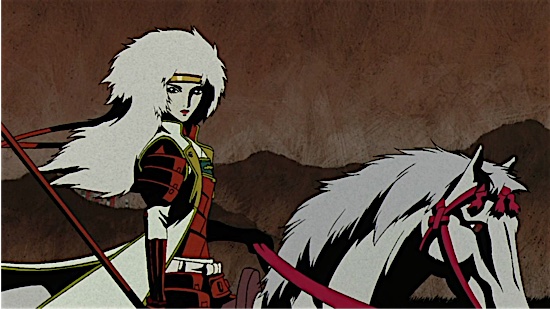
The Animatrix is, without a doubt, the best thing to come out of the Matrix franchise since the original movie. At the height of the series’ popularity between production of the Matrix Reloaded and Revolutions, the Wachowskis recruited the talents of seven of the most preeminent directors working in the field of anime to co-create an anthology of nine short films set within and around the continuity of the Matrix universe. All the familiar tropes are present: the mirrorshades, the kung fu acrobatics, the pulsing rain of digital kanji. But the greatest quality of the Animatrix anthology was in refracting the singular vision of the Wachowskis to a kaleidoscope of yet-unexplored visual and conceptual possibilities within the series’ core concept. Whether it be Mahiro Maeda’s chilling prequel in “The Second Renaissance,” Shinichiro Watanabe’s low-tech noir mystery in “A Detective Story,” or Peter Chung’s bizarre and psychedelic journey into the mind of a human-designed matrix with “Matriculated,” the Animatrix dove directly into heart of films’ collective mythology and reimagined it with every last drop of untapped creativity the series had then yet to muster.
55. Gundam Wing: Endless Waltz (2000)
Director: Yasunao Aoki
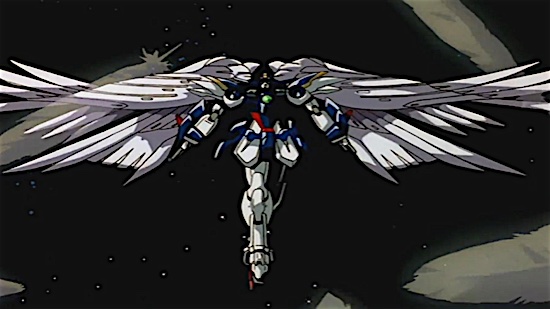
Endless Waltz was originally produced as a three-part OVA wrapping up the story of the Gundam Wing TV series, which takes place outside the normal continuity of the Gundam “Universal Century” timeline. The movie cut is the superior viewing experience, however. Endless Waltz takes place one year after the events that wrapped up Gundam Wing, and involves the Gundam pilots, and their enemy Zechs Merquise, coming out of retirement to battle one last threat—and in some cases, each other. Where the Gundam Wing TV series had a plot that tended to meander, and sometimes used cheap animation or repeated cels, Endless Waltz is a feast for the eyes—filled with gorgeous, fluid battle scenes that any fan of giant robots will appreciate. Add to that the very smart decision to have the great Katoki Hajime (Short Peace, Gundam 0083) redesign the Gundams into their “evolved” forms, and this becomes much more than a simple end of series cash-in. For this film version, several shots from the OVA were retouched, and there are some mild adjustments to the original animation. As a payoff to the TV series, it’s a great way to visit with the Gundam pilots one last time, and as a stand alone, it works well enough that even if one is not familiar with the source material, it’s a fun ride. The usual questions about the cost of war, the price of peace, and human determinism that run through virtually all Gundam series are on full display here. If you want a concise example of what Gundam does so well relative to other types of giant robot anime, this is a dance worth taking. —J.D.
54. 5 Centimeters Per Second (2007)
Director: Makoto Shinkai
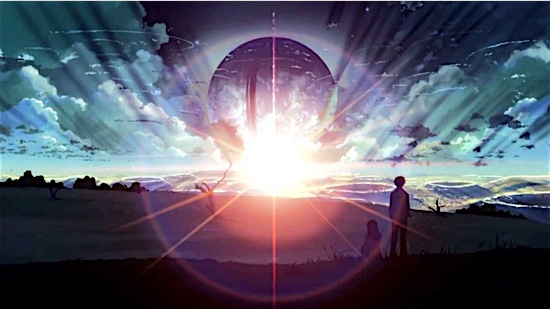
Makoto Shinkai’s fourth and arguably most well-known film, 5 Centimeters Per Second, focuses on the seemingly intractable distance, both physically and emotionally, between two childhood friends who pine for one another all the while the mounting circumstances of their lives intervene to pull them apart. Told across three short stories, the film follows Takaki Tono through childhood, adolescence, and eventually adulthood, documenting how his unrealized romance with his former best friend, Akari Shinohara, both spurs him forward and tragically leaves him incapable of pursuing human connection elsewhere. Set between the early ’90s and late aughts, 5 Centimeters Per Second ingenuously uses the absence and later ubiquity of modern communication technology to tell a story of mixed connections and emotional resonance. Filled with Shinkai’s requisite emotional motifs of loneliness, existential melancholy and romantic ennui, 5 Centimeters Per Second is perhaps the definitive introduction to Shinkai’s oeuvre for aficionados and newcomers alike.
53. My Neighbors the Yamadas (1999)
Director: Isao Takahata
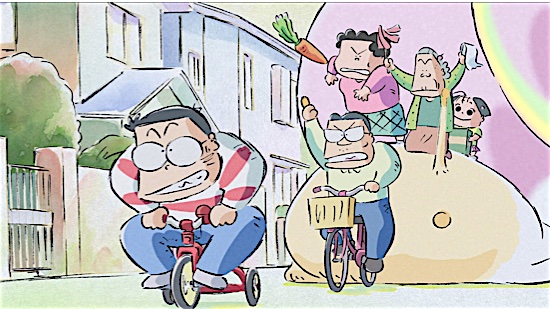
Isao Takahata, for all his legendary status as a director and co-founder of Studio Ghibli, is sometimes a hard director to pin down, stylistically. Case in point: the delightful, virtually plot-free, humane comedy My Neighbors the Yamadas, which looks and feels like nothing else in his oeuvre. Despite this, it somehow also feels like quintessential Takahata. Based on the comic strip manga, Nono-Chan, the film is a series of vignettes centered around the Yamadas, an average family living in metropolitan Japan. These vignettes cover everything from how Takashi and Matsuko (the parents at the center of many of the tales) met, to family arguments over who has control of the TV remote, to grandmother Shige’s advice and proverbs told to the family. Despite not having an overarching story, by the end of the film, each character and their interconnecting relationships are finely and realistically drawn, and it’s easy to find oneself in love with this family, and their silly, crabby humanity. Complex truths about aging, marriage, family, and childhood are expressed through these simple tales about particular family members and their trials, tribulations and daily foibles. Also of note is the striking visual style of the film, designed to look like a watercolor comic strip. Takahata was so firm in his desire to achieve this look that My Neighbors the Yamadas ended up becoming the first fully digital film from Studio Ghibli. Whether you find it slow-moving or delightfully sedate, the visuals will captivate. My Neighbors the Yamadas is a film only Ghibli would make, and only Takahata could shape into such a poignant ode to the humanity of everyday families. Essential Takahata, indeed. —J.D.
52. Cat Soup (2001)
Director: Tatsuo Sato
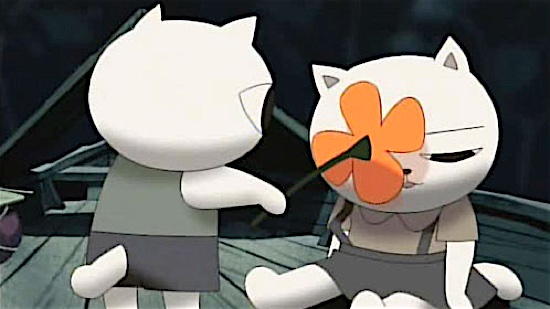
There’s a lot of ways to go about describing Cat Soup to someone who’s never seen it before. Hallucinatory. Macabre. Avant-garde. Adorable. The only thing you can’t call it is boring. Directed in 2001 by Tatsuo Sato and co-conceived by Sato and Masaaki Yuasa, Cat Soup is an award-winning dark comedy short film inspired by the work of cult manga artist Nekojiru. The film is a brilliant example of stream-of-consciousness animation, following the exploits of a young kitten named Nyatta who embarks on a bizarre journey to recover the soul of his sister Nyaako. Describing what happens in the film is insufficient in attempting to understand it as compared to simply watching it. Cat Soup is a disquieting head-trip, a pastel-colored fever dream, and above all else a supremely creative short film that’s as visually entertaining as it is conceptually unnerving.
51. Howl’s Moving Castle (2004)
Director: Hayao Miyazaki
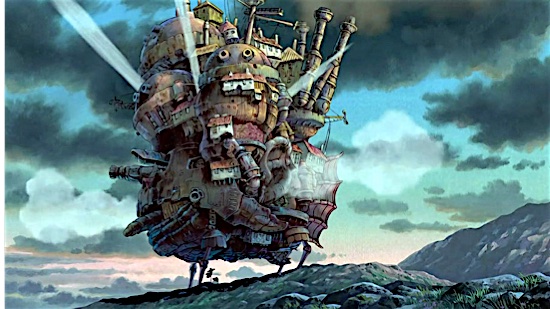
Howl’s Moving Castle was the Miyazaki film that almost didn’t happen. Conceived in 2001 amidst the height of Spirited Away’s success, Mamoru Hosoda was originally slated to direct the adaptation of Diana Wynne Jones’ 1986 novel before he and Ghibli had a falling out due to a conflict of creative visions. Miyazaki seized the reins and made the film his own, crafting the source material into a creative vessel through which he could forge his impassioned contempt for the then-ongoing U.S. invasion of Iraq into a parable about a fruitless magical proxy war between two nations in a steampunk fantasy setting. Howl’s is a whimsical if occasionally tepid adventure of a timid young woman who, after being cursed with the body of an old crone by a jealous witch, is rescued by a charismatic wizard who lives in a gigantic walking house. The film’s titular castle is one of Miyazaki’s finest creations, resembling a bow-legged fish armed with stumpy wings and turrets hobbling across the countryside and shuffling debris to and fro. To be sure, though its finale is a bit muted and the abrupt resolution of a love story in the movie’s denouement is a bit too neat and tidy, the film is a quintessential Miyazaki effort nonetheless that’s sure to please both newcomers and enthusiasts who might have somehow not seen it yet.
50. Dead Leaves (2004)
Director: Hiroyuki Imaishi
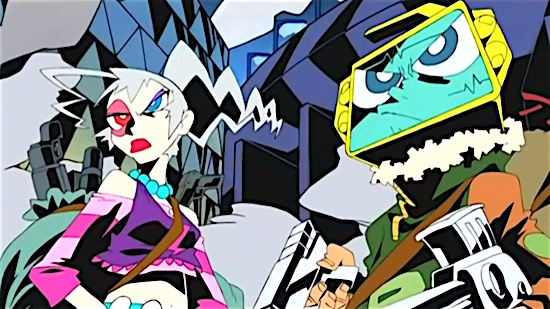
You may not recognize Hiroyuki Imaishi’s name from a first glance, but in his career as an animator and director over the past two decades, he has amassed a body of work that’s iconic among post-millennial animation. Most recognized for his work as an animator on shows like FLCL and Neon Genesis Evangelion before going on to direct such cult classic series as Tengen Toppa Gurren Lagann and Kill La Kill, his directorial feature debut, Dead Leaves, is a pure encapsulation of all of Imaishi’s idiosyncrasies and quirks as a director. The film follows the hyper-violent misadventures of two amnesiac criminals sentenced to life imprisonment aboard a space penitentiary embedded in the remnants of the moon. The film’s art style resembles what one would picture from an hyper-stylized underground cult comic from the ’90s, albeit injected with an industrial-sized adrenaline shot of anarchism, profanity and phallic imagery. The sum total of Imaishi’s aesthetic legacy can be traced back to Dead Leaves, whether it be his affinity for drill imagery that would later take center stage in Gurren Lagann or the frenzied hyperactive gunfights that would pop up in his work on FLCL. Dead Leaves is unapologetically low on story and crammed wall to wall with style, but when this combination plays so well to the director’s strengths, excess is absolutely what you want out of a film like this.
49. Ghost in the Shell 2: Innocence (2004)
Director: Mamoru Oshii
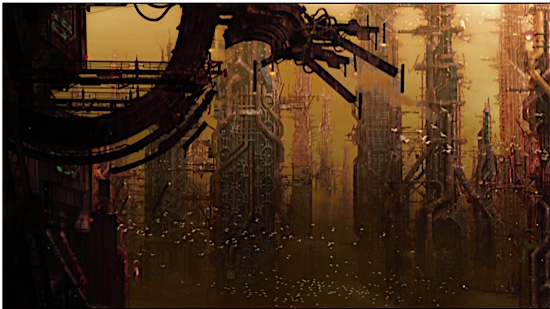
Ghost in the Shell 2: Innocence is a sharp detour, both visually and conceptually, from the tone and tenor of Oshii’s 1995 classic. Set three years after the events of Ghost in the Shell and the disappearance of Major Motoko Kusanagi, Innocence follows Batou, the Major’s former partner and acting field commander of Public Security Section 9. While investigating a wave of murders perpetrated by an experimental line of sex gynoids, Batou and Section 9 uncover a deadly conspiracy linked to a rash of mysterious disappearances that extends to the highest echelons of the Japanese government. As Batou plunges into the depths of the criminal underground in his search for answers, he begins to question the extent of his own humanity as a prosthetic cyborg. Can someone ever truly recreate themselves? What does it mean to be happy? And will the Major ever truly return? Innocence is a noticeably different film than the original in regard to its tone and subject matter. Approaching it less as a sequel and more of epistemological investigation through the medium of anime, Oshii doubles down on the Christian esotericism and philosophical koan-esque questions that define the greater part of his work to create a film that, although visually impressive and conceptually complex, feels bogged down in its latter half by the weight of too much ambition. If you’re a Ghost in the Shell devotee, Innocence is definitely recommended: a dense excavation into a wellspring of ideas and questions that don’t often come to the forefront of contemporary cyberpunk stories. If you’re more of a casual viewer, stick with the somewhat more palatable (but no less profound) 1995 original.
48. Voices of a Distant Star (2002)
Director: Makoto Shinkai
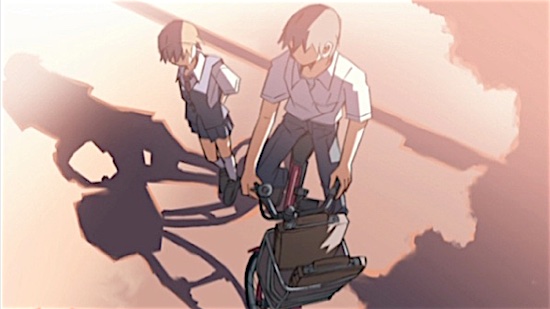
Makoto Shinkai’s debut is a testament to his skill as a director, and a primer for every broad emotional and aesthetic through line that would go on to define his work. When middle-schooler Mikako Nagamine is recruited by the UN Space Army to serve as a mecha pilot to fight off an alien threat striking at human civilization from the fringes of the solar system, she leaves behind her friend Noboru Terao on Earth. Initially committed to being pen pals, the gulf of time between their responses grows longer and longer given the relative distance of Mikako’s ship traveling from Earth. Produced almost entirely by Shinkai himself with music composed and performed by long-time friend and collaborator Tenmo, Voices of a Distant Star hones in on the themes of time, space and distance, and how they impact the fragility of human relationships in a way that few other works can, securing Shinkai’s status as one of anime’s premier auteur directors.
47. Jin-Roh: The Wolf Brigade (1999)
Director: Hiroyuki Okiura
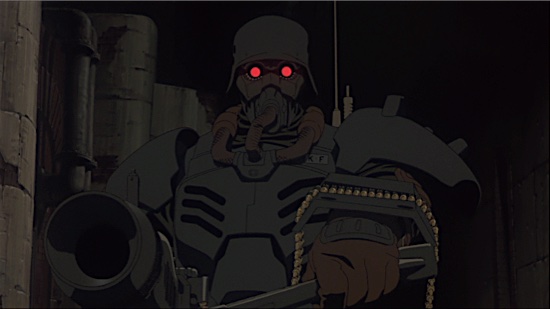
Written and storyboarded by Mamoru Oshii, Jin-Roh: The Wolf Brigade is Hiroyuki Okiura’s feature film debut and the third and final installment in Oshii’s Kerberos trilogy. Jin-Roh follows a member of an elite anti-terrorist police unit who, after failing to subdue a mysterious suicide bomber in the midst of a heated riot, is plagued by disquieting visions and doubt regarding the virtue of his service. The film is as thematically complicated as it is aesthetically breathtaking, with superbly realistic animation, deafening firefights and oppressive melancholic ambiance owed in part to Hajime Mizoguchi’s score. Jin-Roh: The Wolf Brigade is an audacious reimagining of Charles Perrault’s “Little Red Riding Hood” set in an authoritarian alternate history Japan where the lines between the wolf and the girl, the hero and the villain, become blurred to the point where the two are rendered tragically indistinguishable by their fallibility.
46. The End of Evangelion (1997)
Director: Hideaki Anno, Kazuya Tsurumaki
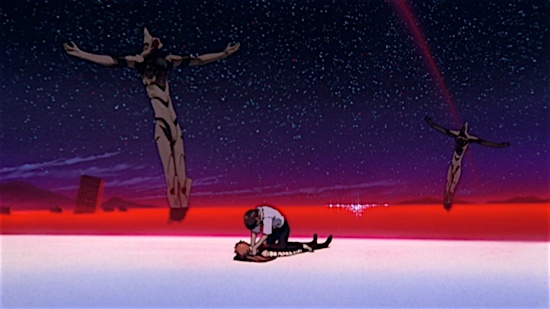
The final two episodes of Neon Genesis Evangelion are notorious among fans of the series.Titled “Do you love me?” and “Take Care of Yourself,” the two-part finale infamously sidelined the climactic finale to the series’ central conflict, instead opting to take place entirely away from the action within the subconscious of the show’s protagonist, Shinji Ikari, as he wrestled to resolve the self-loathing and hatred which plagued him throughout the story’s duration. The unconventionality and unsatisfying nature of this conclusion prompted disgruntled fans to issue death threats on Anno’s life and Gainax’s building to be defaced with graffiti. In response, Anno set to work on an alternative ending to the series to be produced in two parts and aired in theaters. If you were looking for a light, campy and celebratory conclusion, End of Evangelion is not that movie. Instead, what fans were treated to was perhaps one of the most fatalistic, avant garde, and oddly enough, life-affirming endings to an anime series ever produced. In short, it is the best and worst of everything that is Evangelion combined to create a film that is unlike anything that had come before it. Despite its unrelenting darkness, End of Evangelion remains true to the ethos of its subtitle, that the joy of death is in the act of rebirth.
45. Galaxy Express 999 (1979)
Director: Rintaro
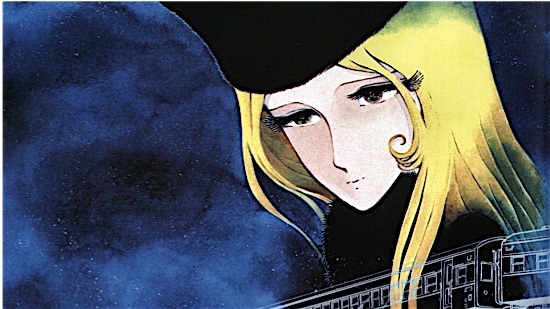
Leiji Matsumoto was, along with Go Nagai, one of the preeminent creators of manga and anime in Japan in the 1970s. He is best known for his Yamato series, but his ultimate artistic achievement is perhaps the shared universe represented by the Galaxy Express 999, Captain Harlock and Queen Emeraldas manga and anime series. Galaxy Express 999 started as a manga, then became a 113-episode anime, and culminated in a series of films, of which the self-titled is the first. Directed by the great Rintaro (Metropolis, X, Neo-Tokyo), and written by and adapted from Leiji Matsumoto’s manga, Galaxy Express 999 is quintessential Leiji. The story (inspired by the classic novel A Night on the Galactic Railroad) concerns a distant future where humans have developed the ability to download their consciousness into robot bodies, essentially achieving immortality—but also losing some measure of humanity. Only the richest humans can afford this procedure, and the poor are forced to live in squalor and die in backwater areas. Tetsuo Hoshino is a young boy whose mother was determined for them both to become immortal. Hearing of the legend of the galactic train, the Galaxy Express 999, whose passengers are guaranteed immortality, he meets Maetel, a mysterious woman who controls the train and offers to grant his wish if he keeps her company along the way. Exploring concepts like class struggle, immortality and what it really means to be human, Galaxy Express 999 is a heady piece of work. Leiji’s designs remain very idiosyncratic, his style being highly defined by this point, and though this film was made for a relatively small amount of money, the backgrounds and designs are uniformly beautiful. The animation itself is not really above the quality of the TV series upon which it was based, but that doesn’t really hurt the proceedings. As a way of summing up over a hundred episodes of story into one film, it’s a surprisingly lucid, affective piece of melancholy science fiction—Leiji’s specialty. It was a smash at the Japanese box office, leading to a somewhat confusing sequel, Adieu Galaxy Express 999, three years later. It was adapted for the U.S. market in 1980 by Roger Corman’s production company, and as was typical for the time, highly edited and changed for American consumption. Stick to the original with this one. A good place to start with Leiji Matsumoto, when you are ready to go beyond Yamato. —J.D.
44. Steamboy (2004)
Director: Katsuhiro Otomo
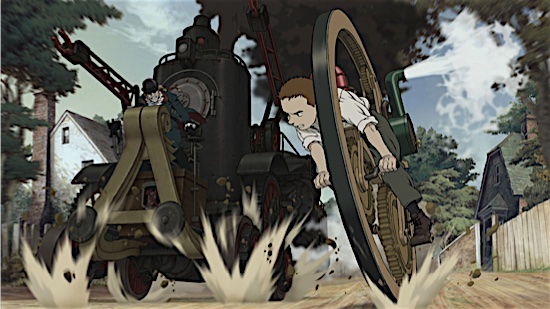
Steamboy, Katsuhiro Otomo’s long awaited follow-up to his defining 1988 film Akira, is remarkable for many reasons. Set in 1866 amid the landmark Great Exhibition in London, Steamboy is a high-flying steampunk adventure centered on a young inventor named Ray and a powerful object engineered by his genius scientist father and grandfather. The film is replete with the intricate details and expressive character animations that are synonymous with Otomo’s reputation as a master of the craft. The set-pieces are sweeping, and the action is entertaining, but there’s something missing. The plot plods and grinds to an excruciatingly slow pace during the film’s third act with just an hour left of the movie. The supporting characters are slight and ultimately insignificant to the arcs of either the protagonist or antagonist. And the film’s central theme, the question of what do the pursuit of science and industry owe to the whole of humanity, comes across as at best muddled and at worst disappointingly simplistic. Inspired initially by Otomo’s short “Cannon Fodder” for his 1995 anthology Memories and the pulp fantasy adventure novels of Edward Ellis and Harry Enton, Steamboy’s production lasted just shy of a decade, consisted of over 180,000 drawings and 440 computer-animated cuts, and cost an estimated $20 million. With that being said, despite its shortcomings, Steamboy remains a visually impressive technical achievement in modern animation. It’s a low mark in a filmography of outstanding work that still manages to crest higher than the majority of works it was released alongside of.
43. Porco Rosso (1992)
Director: Hayao Miyazaki
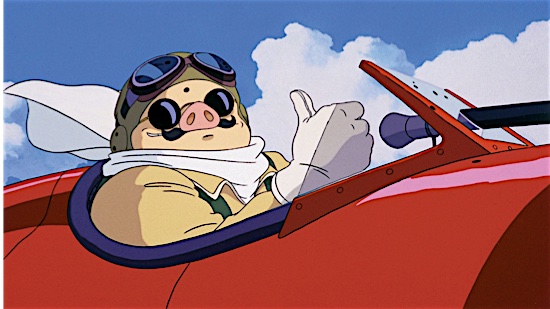
Sometimes cited as “lesser Miyazaki,” Porco Rosso is actually one of his most complex and melancholy films. Set in Croatia in the years immediately following World War I, the film revolves around the the titular character, an ex-WWI flying ace who has been turned into a human-sized pig through a mysterious curse (which is never really explained, only alluded to). Most of the film covers the story of Porco’s rivalry with a brash American pilot, Curtis, and their competition to win the hand of Gina, Porco’s longtime friend and the love of his life. Originally commissioned as a short in-flight film for Japan Airlines based on Miyazaki’s short manga, it slowly expanded into a feature film—and was of course a huge hit in Japan, despite being a bit of a departure for Miyazaki. Up until his most recent film, The Wind Rises, Porco Rosso was the Studio Ghibli film that perhaps had the most “Miyazaki” in it. His obsessions with European towns, the forward march of technology, the disruptive effect of war, plucky young heroines, and of course, planes and flight, are more than just foregrounded here—they are the film. The entire enterprise has a mournful, melancholy feel, and thus a possibly ridiculous situation (a pig living his life as a man) is given a surprising amount of pathos. Porco pretends not to care that he isn’t human any more, and we learn that he feels he was cursed due to an act of cowardice in battle—although it’s never really clear if there’s anything he could have done differently. Porco’s mournfulness and survivor’s guilt permeate everything he does, and his resignation at his transformed state stunts his growth in other areas, making him a particularly sad protagonist. Paced more deliberately than other Miyazaki films, Porco Rosso comes together for a rousing climax, a beautifully realized dogfight that lives up to the insanely high bar set by Miyazaki’s other flying sequences. Along with The Wind Rises, Porco Rosso is one of Miyazaki’s least fanciful films, using real planes, a real location, and set during real events. More grounded than a fantasy about a pig man would suggest, Porco Rosso nevertheless reaches heights that will leave any anime fan breathless—and does it in style. —J.D.
42. The Girl Who Leapt through Time (2006)
Director: Mamoru Hosoda
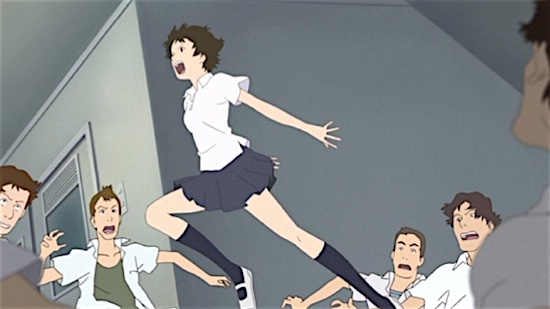
Though The Girl Who Leapt through Time may not technically be Mamoru Hosoda’s first turn as a director, it’s nonetheless the film that first introduced his name to the world stage and affixed the albatross title of “the next Miyazaki” around his neck. Based on Yasutaka Tsutsui’s 1967 novel, Hosoda’s film is a spiritual successor of sorts to the original. Makoto Konno is by all appearances an average high school girl with a habit of clumsiness and oversleeping. But after discovering a mysterious artifact while hanging around after class, she soon discovers that she has the ability to “leap” backward through time. What then begins as frivolous dalliances of youthful indiscretion soon enough cascades into an unforeseen series of chain reactions that threaten to shake her life to the core and force her to commit to the consequences of her actions. It’s a beautiful film for sure, with terrific animation confidently bringing Yoshiyuki Sadamoto’s signature character designs to life. Like all great science-fiction, The Girl Who Leapt through Time offers the satisfaction of speculative wish fulfillment combined with an earthly lesson that touches home: time waits for no one, and no matter our fears or regrets, an inescapable part of growing up means taking a leap of faith into the unknown and learning how to fly on our way down.
41. The Place Promised in Our Early Days (2004)
Director: Makoto Shinkai
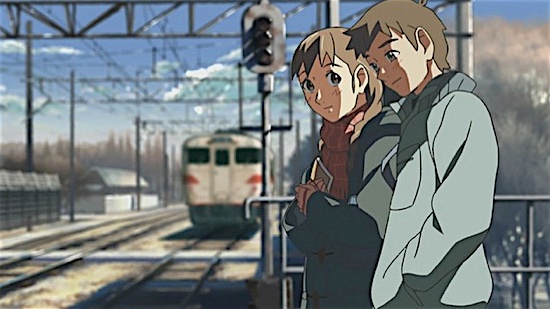
Trying to nail down Makoto Shinkai’s “best” film is a difficult task, to say the least. While none of his films are “bad” per se, his work has the tendency to retread a common arrangement of visual and thematic motifs that, although entertaining, leave something to be desired in the way of range. To put it simply: If you’ve seen one of his films, you can reliably guess what his others will be like. That’s what makes The Place Promised in Our Early Days so exemplary. It touches on all of Shinkai’s major themes and emotional beats (“lonely sadness,” ennui, romantic melancholy) and wrapping his aesthetic sentimentality in a strong sci-fi fantasy drama that gives those beats heft and a satisfying course of resolution. Shinkai’s first feature-length production, The Place Promised in Our Early Days is set in an alternate universe where Japan has been stratified into two opposing territories occupied by the Soviet Union and United States. The film follows the stories of Hiroki, Takuyi and Sayuri, three childhood friends who in 1996 form a pact to one day fly to the mysterious spindling tower built on the Union’s territory and discover its secrets. This adolescent quest soon escalates into a dramatic international conflict involving parallel dimensions, false realities and experimental technology. Flushed with the grandiose settings of sepia-coated cloudscape that Shinkai is best known for, The Place Promised in Our Early Days hones the director’s talents to a fine point, delivering an exhilarating emotional high in its final climactic moments.
40. A Silent Voice (2016)
Director: Naoko Yamada

In a medium that too often feels at times constricted by the primacy of masculine aesthetic sensibilities and saturated with hyper-sexualized portrayals of women colloquially coded as “fan service,” Naoko Yamada’s presence is a welcome breath of fresh air, to say nothing of the inimitable quality of her films themselves. Inspired by the likes of Yasujiro Ozu, Alejandro Jodorowsky, Sergei Parajanov, Sofia Coppola, and Lucile Hadzihalilovic, Yamada is a director par excellence, capable of arresting attention and evoking melancholy and bittersweet catharsis through delicate compositions of deft sound, swift editing, ephemeral color palettes, and characters with rich inner lives rife with knotty, relatable struggles. A Silent Voice, adapted from Yoshitoki Oima’s manga of the same name, is a prime example of all these sensibilities at play. When Shoya Ishida meets Shoko Nishimiya, a deaf transfer student, in elementary school, he bullies her relentlessly to the amusement of his classmates. One day when Shoya goes too far, forcing Shoko to transfer again for fear of her own safety, he is branded a pariah by his peers and retreats into a state of self-imposed isolation and self-hatred. Years later, Shoya meets Shoko once again, now as teenagers, and attempts to make amends for the harm he inflicted on her, all while wrestling to understand his own motivations for doing so. A Silent Voice is a film of tremendous emotional depth, an affecting portrait of adolescent abuse, reconciliation, and forgiveness for the harm perpetrated by others and ourselves.
39. Interstella 5555 (2003)
Director: Kazuhisa Takenouchi
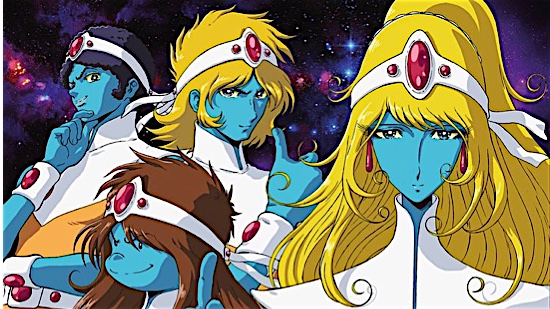
Back in 2003, Daft Punk were on top of the world. Coming off the release of their breakout sophomore album Discovery with chart-topping singles like “Aerodynamic” and “One More Time,” the duo has confidently secured their place at the apex of the EDM zeitgeist. However, the pair had yet still more surprise up their sleeves. During the early recording sessions of Discovery, Thomas Bangalter and Guy-Manuel de Homem-Christo co-wrote a screenplay based on the album with the intent of pitching it to their childhood hero, Leiji Matsumoto. One year before the album’s release, the pair travelled to Tokyo to present their idea to Matsumoto, which he accepted. The rest, they say, was history. Reportedly costing $4 million to produce, Interstella 5555 transformed an album that many thought to be absent of any hint of story and transformed into a grandiose EDM space opera rock odyssey centered on the perilous kidnapping and subsequent rescue of a blue-skinned alien rock band from the nefarious clutches of a label executive bent on galactic domination. More than just a serendipitous alignment of two immensely creative forces, Interstella 5555 surpasses the limitations of having no spoken dialogue to become a fascinating allegory for the appropriation of talent and the predatory machinations of the entertainment industry. It’s a one-of-a-kind collaboration that feels like a film pulled from some impossible, alternate dimension that should be seen by dance music fans and anime aficionados alike.
38. Vampire Hunter D (1985)
Director: Toyoo Ashida
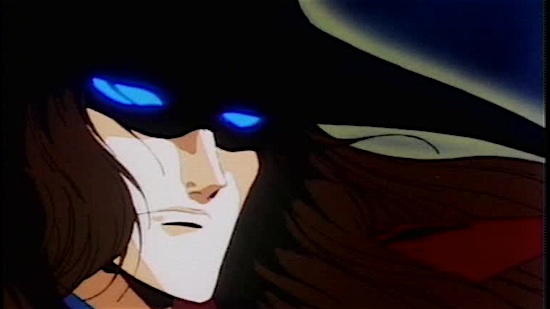
Being an anime fan in the late ’80s/early ’90s was more difficult than it is today, with the wealth of streaming options available to younger fans. In the pre-internet, VHS era, U.S. anime fans were forced to choose from what was available at their local video store- or black market illegal fansubs. To otaku of a certain age, Vampire Hunter D is a classic of this bygone era. One of the first “adult-themed” anime to come across the pond and end up at places like Blockbuster—for you younger readers, that was Netflix before Netflix—it was pretty much required viewing by any budding anime fan. In fact it’s fair to say that for a time, Vampire Hunter D had higher awareness among U.S. fans than any anime with the exception of Akira, or one or two other major titles. The story, adapted from Hideyuki Kikuchi’s 1983 novel, is a relatively simplistic gothic western set against a post-apocalyptic backdrop and following the adventures of the dhampir (half-vampire) “Vampire Hunter D.” D himself is properly mysterious and taciturn in the classic mode of Japanese male protagonists, speaking rarely and generally being more of a “man of action.” This is good, as the script adaptation and dub are pretty rough (there has since been a Blu-Ray release of the film with the original Japanese dialogue). Where Vampire Hunter D excels is in its design, by the legendary Yoshitaka Amano, and direction, by Toyoo Ashida (Fist of the North Star). As an OVA, the animation quality is better than the average TV series of the era, but not up to the level of a theatrical release. A superior follow-up film, Vampire Hunter D: Bloodlust, was released 15 years later, and the series of light novels upon which the films are based still continues today. From today’s perspective, Vampire Hunter D is a dated, almost charming, example of a time when this sort of semi-adult cartoon content was considered “dangerous” to budding young anime fans in the United States. Along with a few other key titles like Wicked City and Ninja Scroll, Vampire Hunter D lit the flame for many older anime fans, and for that reason alone it deserves to be appreciated. —J.D.
37. Castle in the Sky (1986)
Director: Hayao Miyazaki
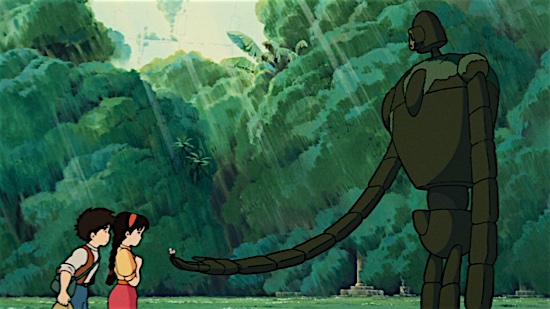
Coming off the critical and commercial success of Nausicaä of the Valley of the Wind, Hayao Miyazaki would go on to found Studio Ghibli alongside his mentor and collaborator Isao Takahata and Toshio Suzuki before immediately setting to work on the studio’s first major production. Castle in the Sky, alternatively titled as Laputa: Castle in the Sky, opens with a young girl named Sheeta who, after narrowly escaping the clutches of a band of air pirates who seek to exploit her for unknown ends, is miraculously saved as she falls from a flying airship by a mysterious amulet that levitates her safely to the ground. She lands in the careful arms of Pazu, a young boy from a local mining village who dreams of one day discovering the fabled floating city of Laputa and vindicating his father’s memory. What follows is a two-hour high-action adventure between the pair being doggedly chased by pirates, the military and an unscrupulous government agent—all on a quest to find the legendary castle and manipulate its untold treasures and secrets to their own nefarious ends. Castle in the Sky is a tremendous film powered by pure propulsive momentum, each setting filled with back-to-back hilarious and harrowing moments that would give Indiana Jones a run for its money in terms of action and spectacle. Inspired by the likes of Gulliver’s Travels and Judeo-Christian folklore, the floating city of Laputa is just one of the countless iconic locations that Miyazaki has conjured into the collective imagination throughout his near-fifty-year-long career. Though perhaps not as well-known as Princess Mononoke or Spirited Away, Castle in the Sky is nonetheless an essential entry in Studio Ghibli’s filmography of classics.
36. Appleseed (2004)
Director: Shinji Aramaki
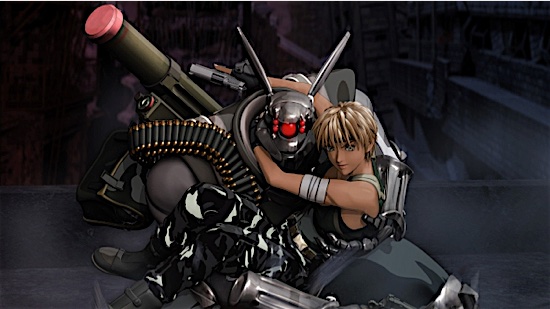
Based on Masamune Shirow’s 1985 award-winning sci-fi action manga series, Appleseed tells the story of ESWAT soldier Deunan Knute and her cyborg lover Briareos, who are charged with defending the utopian city of Olympus amid the turmoil of a post-apocalyptic world. Already well-respected for his mecha designs for such series as Megazone 23 and Bubblegum Crisis, Appleseed was Shinji Aramaki’s feature-length debut and noteworthy for its extensive use of CGI and cel-shading technology. Though far from the first anime to be exclusively produced in this format and released just three years after the critical and commercial windfall of Square Enix’s Final Fantasy: The Spirits Within, Appleseed was quintessential in proving the vitality and convenience of using CGI in anime production when put in the right hands. With great visuals, solid action, an infectious techno soundtrack courtesy of Japanese electronic duo Boom Boom Satellites, and a serviceable if clichéd plot, Appleseed remains a significant touchstone in the history of early-aught animation and, on top of that, a pretty entertaining watch to boot.
35. Panda! Go, Panda! (1972)
Director: Isao Takahata
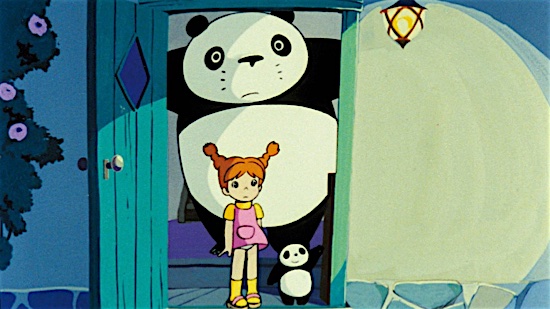
If you’re looking for the direct spiritual predecessor to the likes of My Neighbor Totoro or Ponyo, you’ll have to turn your focus all the way back to 1972, a full thirteen years before Studio Ghibli was founded. Initially released that year as a 33-minute theatrical short film before being expanded a year later with a second installment titled The Rainy-Day Circus, Panda! Go, Panda! introduced the trope of a lovable and mischievous sidekick character that would later become a constant throughout some of the studio’s best known works. Conceived, scripted and storyboarded by Hayao Miyazaki and directed by his mentor Takahata, Panda is the story of a little girl named Mimiko who, after being left home alone while her grandmother is away, becomes the adoptive daughter and surrogate mother to a giant talking panda and his son Panny. It only gets weirder from there. Mimiko is a Pippi Longstockings-like character who is unfazed by the sheer insanity that surrounds her, while her lovable panda father has a low-key psychotic vibe about him when it comes to his obsession with the bamboo grove outside Mimiko’s house. Still, Panda! Go, Panda! isn’t meant to be taken seriously. It’s a fun, cutesy children’s film with an infectious theme song that satisfies in its simplicity while also being a fascinating precursor to what Studio Ghibli would go on to perfect in their later work.
34. Robot Carnival (1987)
Director: Various
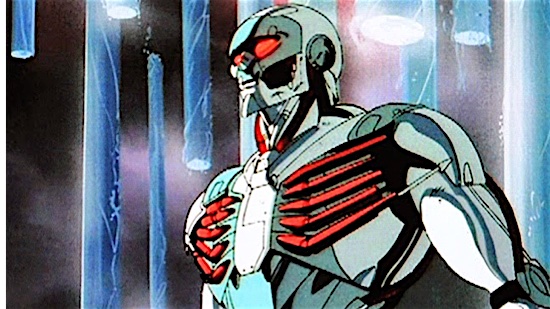
Silent animated shorts set to dramatic orchestral music, commonly known as Silly Symphonies, were all the rage in America throughout the 1920s and ’30s. Perhaps the most famous example from this era of animation was Fantasia, produced by Walt Disney and released to critical acclaim in 1940. Robot Carnival is anime’s answer to that film, a collection of nine short films produced by nine of the most esteemed anime directors and character designers of their time. For sure, not every short shines as a pillar of canonical greatness, e.g., Hiroyuki Kitazume’s “Starlight Angel” or Hidetoshi Omori’s “Deprive.” But when a short does shine, it’s a sight to behold. Koji Morimoto’s “Franken’s Gear” is a brilliant choice for an opener, while Manabu Ohashi’s “Cloud” is a melancholic gem that memorably experiments through the use of scratchboard animation. Hiroyuki Kitakubo’s “Strange Tales of Meiji Machine Culture: Westerner’s Invasion” is a imaginative take on the Giant Robot subgenre that’s as ridiculous as its name, and Takashi Nakamura’s “Chicken Man and Red Neck” is the true anime analog to Fantasia’s iconic “Night on Bald Mountain.” Even if Robot Carnival was not an awesome collection—and it is—it would still be a remarkable timestamp of when a constellation of talented young director align to create a project born completely out of a love for the medium.
33. Mobile Suit Gundam: Char’s Counterattack (1988)
Director: Yoshiyuki Tomino
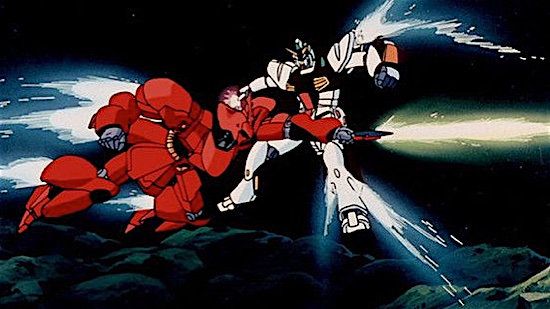
The first Gundam theatrical and final chapter in the original saga begun in 1979 with the “Universal Century Timeline” of the Mobile Suit Gundam TV series, Char’s Counterattack has the weight of three seasons of TV behind it. Yoshiyuki Tomino, creator of the Gundam series, directed and wrote the film, adapting it faithfully from his novel, Hi-Streamer. Widely considered the best film in the Gundam franchise, Char’s Counterattack is most successful at wrapping up the 14-year rivalry between the “hero” of the Earth Federation, Amuro Ray, and the leader of Neo-Zeon, Char Aznable. The story involves a classic Gundam dilemma: Char’s Neo-Zeon force attempts to drop an asteroid filled with nuclear weapons onto Earth, which would free the colonies from the yoke of oppression by their rivals, the Earth Federation, and kill everyone on Earth in the process. As with all of the best Gundam tales, Tomino approaches the story from a hard sci-fi point of view, clearly laying out the science behind things like giant mobile suits and “newtypes” (humans that have evolved to acquire psychic abilities). Tomino carefully lays out the reasoning behind Char and Amuro’s passions and hatreds, not allowing the viewer to choose a clear side. Gundam series have always been willing to take on discussions about the horrors of war and how mankind, for all its advancements, never seems to be able to free itself from humanity’s baser instincts. Char’s Counterattack attempts this as well, yet it’s mostly concerned with wrapping up the rivalry between Amuro and Char—and on that note, it succeeds wildly. Featuring gorgeous, tense fight sequences set in space, an excellent soundtrack by Shigeaki Saegusa, and some of the most lauded Gundam designs in the history of the franchise, the film is inarguably one of the high points of the Gundam Universe. One down side: if you don’t have the investment of spending hundreds of episodes of television with these characters, the plot can be confusing, and Char/Amuro’s ending will likely not resonate as strongly. Regardless, Char’s Counterattack remains a key moment in the Gundam universe, one still worth checking out almost 30 years later. Hail Zeon! —J.D.
32. Mirai (2018)
Director: Mamoru Hosoda

Most if not all of Mamoru Hosoda’s original films produced in the past decade function, to some degree or another, as exercises in autobiography. Summer War, apart from a premise more or less recycled from Hosoda’s 2000 directorial debut Digimon Adventure: Our War Game!, was the many times removed story of Hosoda meeting his wife’s family for the first time. 2012’s Wolf Children was inspired by the passing of Hosoda’s mother, animated in part by the anxieties and aspirations at the prospect of his own impending parenthood. 2015’s The Boy and the Beast was completed just after the birth of Hosoda’s first child, the product of his own questions as to what role a father should play in the life of his son. Mirai, the director’s seventh film, is not inspired from Hosoda’s own experience, but through the experiences of his first-born son meeting his baby sibling for the first time. Told through the perspective of Kun, a toddler who feels displaced and insecure in the wake of his sister Mirai’s birth, Mirai is a beautiful adventure fantasy drama that whisks the viewer through a dazzling odyssey across Kun’s entire family tree, culminating in a poignant conclusion that emphasizes the beauty of what it means to love and be loved. Mirai is Hosoda’s most accomplished film, the recipient of the first Academy Award nomination for an anime film not produced by Studio Ghibli, and an experience as edifying as it is a joy to behold.
31. Kiki’s Delivery Service (1989)
Director: Hayao Miyazaki
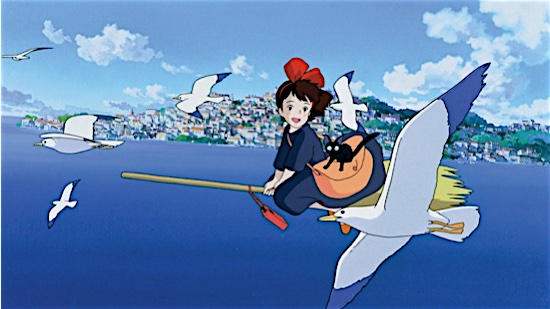
Based on Eiko Kadono’s popular 1985 young adult novel, Kiki’s Delivery Service is a cheerful and charming story of adolescent independence and growing up. Miyazaki’s fourth film under Studio Ghibli follows the titular Kiki, a 13-year-old witch who ventures out into the world from the comfort of her hometown for a year to begin her training as an adult. Noticeably lacking in any sort of antagonist or grand adventure, Kiki’s Delivery Service focuses instead on the everyday struggles of a young adult coming into her own, albeit with a magical twist. Finding a place to stay, securing a job, learning how to make new friends and taking on more responsibilities: these are the sort of stakes that define Kiki’s journey and make her story an endearing one. Miyazaki’s affinity for depicting flight shines through every scene of Kiki wrestling against the air current to steady her broom mid-flight, her dress billowing in the wind as she jets off in the film’s spectacular finale. Though all of Studio Ghibli’s previous films were modest critical if not financial successes up to this point, Kiki’s Delivery Service was a true watershed moment for the studio, becoming the highest-grossing film in Japan in 1989 and securing critical acclaim both at home and overseas. The film is a story of independence, positivity and the font of inner strength that compels every young person to go out into the world and build a life for his or herself.
30. Tokyo Godfathers (2003)
Director: Satoshi Kon
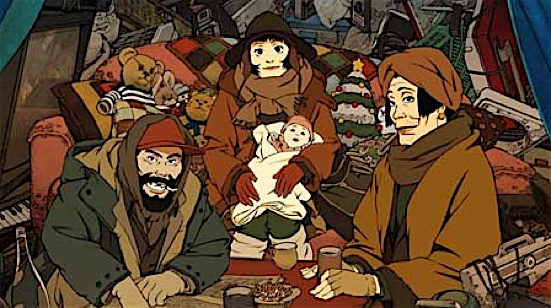
Tokyo Godfathers is something of an outlier, not only among Satoshi Kon’s films, but across the medium of anime as a whole. After all, anime features that depict Christmas as something more than a backdrop are few and far between, especially one that offers such an inspired modern take on the Three Wise Men and the birth of the Christ. Tokyo Godfathers is the story of Gin, Hana and Miyuki, three homeless friends who discover an abandoned baby while rifling through the trash in search of a Christmas present. They resolve to find the child’s parents and bring her safely home, embarking on a journey that takes them to every far corner of the city and inevitably face-to-face with lives they had each abandoned. Named after Robert Ford’s 1948 western take on the christian nativity story, Tokyo Godfathers is Christmas story in the purest sense—a redemptive fable about fallible people and the extraordinary extent through which they go to set one piece of the world, however small, right. Compassionate and hopeful without once cheapening itself with saccharine sentimentality, Tokyo Godfathers resonates with a raw and honest appeal to emotion that merits comparison to the likes of Frank Capra’s It’s a Wonderful Life. If you’re a bit burnt out over Christmas cheer, do yourself a favor and put this one on around the holidays. You won’t regret it.
29. Your Name (2016)
Director: Makoto Shinkai

Much like his contemporary Mamoru Hosoda, Makoto Shinkai is a director who is frequently championed as the “new” Hayao Miyazaki in the conversation surrounding who will succeed him as his heir apparent. This comparison however, much like in the case of Hosoda, ends up being frustratingly reductionist in its appraisal of both directors. Shinkai’s films are not light-hearted family adventures or archetypal pillars of anime canonicity, but tense, melancholic odes to contemporary Japanese society that highlight the ways in which physical, emotional and temporal distance inform the shape and course of human relationships. His fifth feature film, Your Name, exercises Shinkai’s predilection for “star-crossed love” to its narrative and thematic endpoint, situating the budding romance of the film’s protagonists at the epicenter of an astrological event of nothing shy of life-or-death consequence. The recipient of over a dozen awards, in addition to becoming the highest-grossing anime film of its time, Your Name is Shinkai’s most critically and commercially successful production to date, a masterful film that ranks among the very best the medium has to offer.
28. Urusei Yatsura 2: Beautiful Dreamer (1984)
Director: Mamoru Oshii
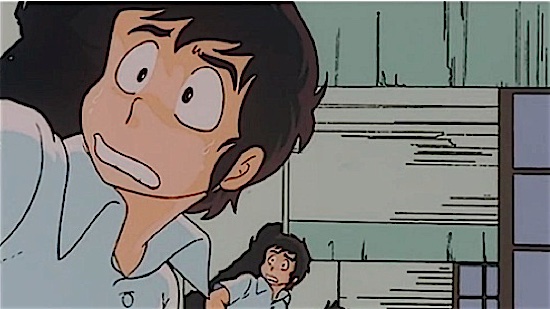
Before his name became synonymous with such titles as Patlabor and Ghost in the Shell, Mamoru Oshii first cut his teeth as an animator directing the television series adaptation of Rumiko Takahashi’s Urusei Yatsura manga and its first two theatrical installments. While the series’ first film, Only You, is a fairly typical fantasy romance-romp that plays close to the formulaic familiarity of the series, Beautiful Dreamer was a far more experimental and ultimately divisive film among the series’ fanbase and set Oshii on the path to become the director we know him as today. Beautiful Dreamer follows Ataru Moroboshi, a lecherous if well-meaning high schooler and his extraterrestrial fiancée Lum as he and his friends scramble to finish preparing for their high school’s annual school festival. It’s not long before they discover something strange is going on, with each day seemingly repeating itself ad infinitum. It’s up to Ataru, Lum and the other to discover what’s causing this bizarre temporal loop, and whether such a state of existence is either a blessing or a curse. With Beautiful Dreamer, Oshii stopped playing to the gratifications of his audience and instead made a film that was, for better or for worse depending on who you ask, entirely his own. In many ways, Beautiful Dreamer can be viewed as the forebear to The Disappearance of Haruhi Suzumiya, at least in terms of its ambition to upend and experiment with the status quo of an established series. If you’re looking for an engaging romance drama that doubles as an important touchstone in the history of one of anime’s most influential directors, Beautiful Dreamer is wholeheartedly recommended.
27. Roujin-Z (1991)
Director: Hiroyuki Kitakubo
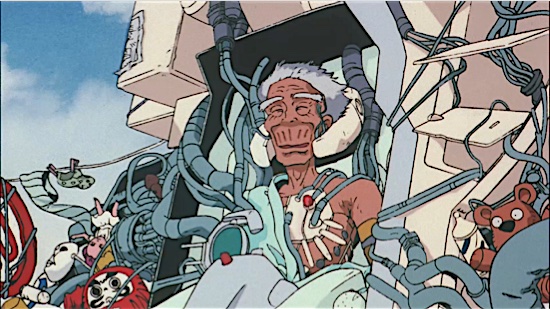
Katsuhiro Otomo is a legend in the field of anime and manga for good reason. Beyond his crowning achievement, Akira, he is responsible for a score of interesting and thought-provoking anime films that continue to push the boundaries of what animation can do. One such case is Roujin-Z, a pitch-black satire of the Japanese health care industry and military industrial complex. Otomo didn’t direct the film—Hiroyuki Kitakubo (Blood the Last Vampire, Golden Boy) did, with Otomo producing, writing and providing mecha designs. This was also the great Satoshi Kon’s first production. All the talent arrayed in the creation of Roujin-Z help make it one of the most singular animated comedies ever made. The story concerns a not-so-distant future where the government has developed a robot that can care for the elderly in every way—cleaning them, entertaining them, allowing them to use the bathroom, all while they remain safely ensconced in the unit. The first person to test the unit is a dying widower named Kiyuro Takazawa. He is deeply unhappy at being placed in the machine, and his unhappiness manifests itself in unexpected ways as his psyche infects the unit, and it begins to use ingrained abilities the government thought no one would discover. Soon enough, the Z-001 is careening across Tokyo, destroying buildings and battling government military hardware, all while Kiyuro wails about going to the beach, where he and his dead wife made some important memories. On paper, this all seems fairly dire, but all of these events are underplayed and lightened by several adorable side characters, from a rogues gallery of mischievous septuagenarian hackers, to Kiyuro’s devoted human nurse, Nobuko. Only Otomo would decide to house a trenchant social commentary about Japan’s discarding of its elderly inside a robot-gone-amok satire of government bureaucracy and greed. Somehow, it all hangs together and makes for a dark but often hilarious satire with some delightful scenes of robotic destruction. The film overall looks more like an OVA than a high-budget feature, but the designs are memorable and based in hard science (again, this is Otomo), and the characters are vibrant and goofy enough to soften the proceedings. Roujin-Z was dubbed in English by Manga Entertainment and released in the United States in 1994, and is still fairly easy to grab subbed or dubbed on DVD. Those looking for more Otomo after Akira would do well to give this unusual gem a look. —J.D.
26. Tekkonkinkreet (2006)
Director: Michael Arias
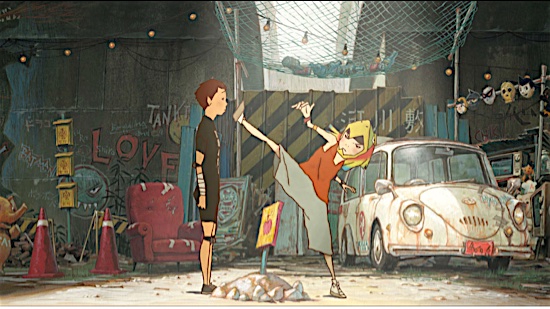
Based on Taiyo Matsumoto’s cult-classic manga, Tekkonkinkreet is a landmark in Japanese animation not only for its extensive hybrid 3D-meets-2D animation but also for being the first major anime feature to be helmed by a non-Japanese director. Tekkonkinkreet follows the stories of Black and White, two orphaned thieves and street fighters who “rule” over the metropolitan sprawl known as Treasure Town. When a small army of extraterrestrial land developers move into town to destroy the low-income housing in and around the city, the brothers attempt to defend their turf and fight back. But lightning-fast punches and death-defying leaps can only delay the inevitable for so long, and Black and White must both eventually come to grips with the consequences of trying to live in the past. Inspired by his time exploring the cityscapes of Hong Kong, Shanghai and Colombo, Treasure Town is almost a character itself—a love letter to the unique chaoticism of pan-Asian industrialism. Tekkonkinkreet is a complicated and compelling story of love and friendship amid a constantly crumbling and reshaping world that feels intimately tied to the communities through which it was inspired. It’s a story about the uneasy turmoil of emotional growth, of holding close to the core of what makes you who you are while learning to let go of everything else that holds you back.
25. Only Yesterday (1991)
Director: Isao Takahata
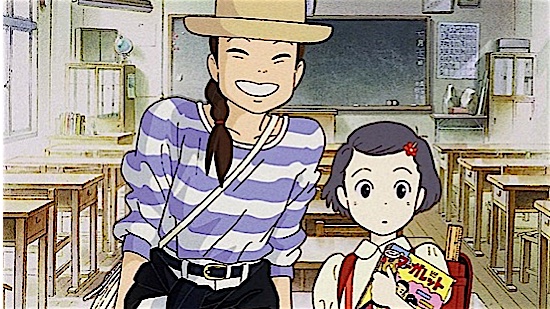
Re-released in American theaters for the first time since its 1991 Japanese debut, Only Yesterday is a simple slice-of-life story of one woman’s childhood and her time spent in the countryside as an adult. Whereas Miyazaki’s films more often skew towards the fantastical, Takahata has a penchant for directing more human dramas that are distinguished with wildly varying and experimental art styles. Only Yesterday follows Taeko Okajima, a 27-year-old unmarried office worker who takes a holiday to visit her extended family in the rural farmlands of Yamagata where she helps to harvest safflowers. While there, she reflects back on her time as a young girl growing up with her parents in Tokyo and how her experiences back then have come to shape her life in the present. Only Yesterday was a rarity when it was first released in 1991: an animated drama tailored for adult audiences near-entirely absent of the gloss of magical realism that defined the majority of Studio Ghibli’s (and most of the anime industry’s) work up to that point. An endearing story of the power of nostalgia and how it shapes perception of the world and of ourselves well into adulthood, Only Yesterday defied expectations and went on to become the highest grossing Japanese film of that year, inspiring a wave of similar “slice-of-life” features and earning Takahata immense critical acclaim. Only Yesterday remains something special nearly twenty-five years later: an earnest and affecting story of a woman continuing to grow and learn well past becoming an adult.
24. Nausicaä of the Valley of the Wind (1984)
Director: Hayao Miyazaki
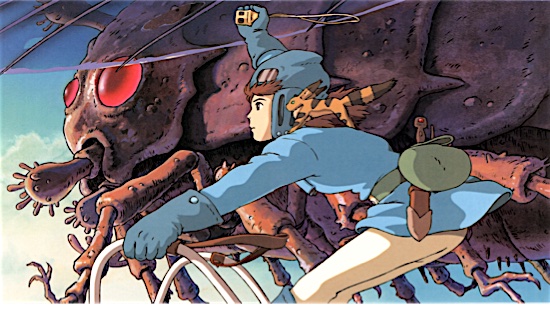
Nausicaä of the Valley of the Wind is, quite simply, the film responsible for the creation of Studio Ghibli. The film not only signaled Miyazaki’s nascent status as one of anime’s preeminent creators, but also sparked the creation of an animation studio whose creative output would dominate the medium for decades to come. Following the release of The Castle of Cagliostro, Miyazaki was commissioned by his producer and future long-time collaborator Toshio Suzuki to create a manga in order to better pitch a potential film to his employers at Animage. What resulted was Nausicaä, a fantasy epic, inspired by the works of Ursula K. Le Guin and Jean “Moebius” Giraud, starring a courageous warrior princess trying to mend a rift between humans and the forces of nature while soaring across a post-apocalyptic world. The success of Nausicaä as a serialized manga would culminate in a film adaptation that would then go on to be heralded as one of the greatest animated films of all-time. Nausicaä was the film that introduced the world to motifs and themes by which Miyazaki would become universally known for: a courageous female protagonist unconscious of and undeterred by gender norms, the surmounting power of compassion, environmental advocacy, and an unwavering love and fascination with the phenomenon of flight. The essentialness of Nausicaä of the Valley of the Wind’s placement within the greater canon of animated film, Japanese or otherwise, cannot be overstated. It spawned an entire generation of animators, among them Hideaki Anno, whose lauded work on the film’s climactic finale would later inspire him to go on to create Neon Genesis Evangelion. If you haven’t seen this film yet, do so immediately. And if you have already, it only gets better with age.
23. Memories (1995)
Director: Various
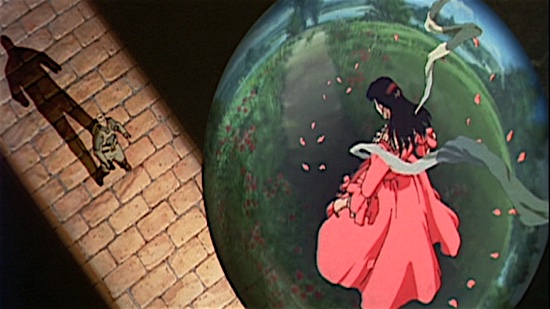
After wrapping production on Akira in 1988, Katsuhiro Otomo returned in 1995 to helm his third anthology collection of short films, titled Memories. Initially scripted around the theme of the collection’s namesake, the anthology eventually yielded a series of three shorts, each directed by one of three of the most acclaimed directors working at the time, Otomo included. The collection’s first segment, “Magnetic Rose,” is unanimously praised as the anthology’s best and for good reason. Directed by Koji Morimoto and scripted by Satoshi Kon, “Magnetic Rose” is emblematic of the themes of perception, identity and uncertainty, which exemplify Kon’s work at its best, depicting the terrifying story of a deep space salvage cruise’s ensnarement in the siren wiles of an aristocratic opera singer. The anthology’s other two installments, Tensai Okamura’s “Stink Bomb” and Otomo’s “Cannon Fodder,” are worth the price of admission as well, the former a crassly comedic take on an extinction-level crisis and the latter a wartime parable animated with a intriguing Terry Gilliam-esque art style in one long take. Whatever your palate as anime film-goer, Memories is not to be missed.
22. Ninja Scroll (1993)
Director: Yoshiaki Kawajira
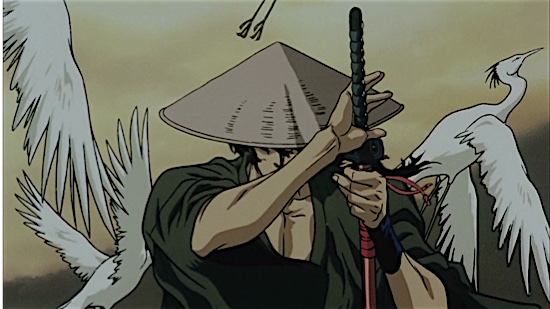
Set during the Tokugawa era of Japan, Ninja Scroll follows the story of Jubei Kibagami, an itinerant samurai warrior (partly inspired by the real-life folk hero, Jubei Yagyu) who is recruited by a government agent to defeat the Eight Devils of Kimon, a cabal of demonic ninja who conspire to overthrow the Tokugawa regime and plunge Japan into destruction. Along the way he meets Kagero, a beautiful and mysterious poison eater, and is forced to confront the demons of his past as he fights to preserve the present. Produced during the boom of anime’s foreign markets, Ninja Scroll was one of the first titles released by Manga Entertainment in the West. Its well-defined animation, unflinching hyper-violence, and impressively creative fight sequences made it a requisite gateway title for early anime fans and is rightfully looked upon as a cult classic to this day. The film qualifies as a time capsule for one of anime’s heyday periods, with exquisite production values married to impeccably crafted set pieces. Ninja Scroll pushed the boundaries of excess, with unflinching depictions of sensuality and sexual violence shown alongside showers of gore and decapitation. The film was front-and-center for the argument that anime “wasn’t just for kids” in the mid-’90s, and qualifies today as a must-see title for a serious anime fan. Yoshiaki Kawajiri’s Ninja Scroll is the quintessential anime chanbara action film, no question.
21. Panda and the Magic Serpent (1958)
Director: Taiji Yabushita, Kazuhiko Okabe
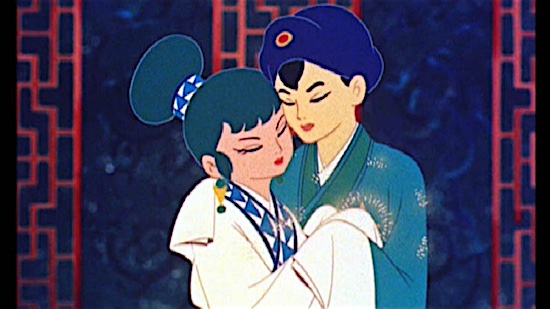
Based on the Chinese folktale The Legend of the White Snake, Panda and the Magic Serpent is noteworthy for being not only being the first full color anime film, but for being the first licensed anime film to be shown in America. In 1952, shortly after the post-war animosities between Japan and the West began to dissipate, Toei studio acquired the rights to the story and five years later set out to adapt it into a feature-length film. Hiroshi Okawa, president of Toei films at the time, had hoped to emulate the personality-driven marketing of Walt Disney with the film, aiming to transform the studio into the so-called “Disney of the East.” Despite receiving honors at the Venice Children’s Film Festival in 1959, the film performed poorly in the states and received a very small theater run. The film’s significance doesn’t stop there though, as Panda and the Magic Serpent is credited by Hayao Miyazaki as one of the films that first inspired him to become an animator and Rintaro, who would later become an influential director in his own right for such films as Galaxy Express 999 and Metropolis, got his first animation job as an in-betweener working on this very film.
20. Mind Game (2004)
Director: Masaaki Yuasa
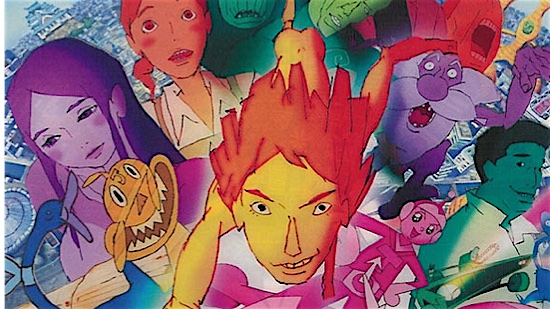
Trying to pin down Masaaki Yuasa’s 2004 breakout debut with a summary is no easy task, as the now-storied director behind such modern anime classics as Kick-Heart, Ping Pong and The Tatami Galaxy revels in defying expectations with his maximalist anything-goes approach to animation. When 20-year-old aspiring comic artist Nishi dies in a yakuza hold-up while attempting to protect his childhood crush Myon, his soul meets God before escaping Limbo and reassuming his body moments before his tragic death. The couple lead a high-speed getaway in one of the Yakuza member’s cars before diving into the ocean and being swallowed into the belly of a … see what I mean? Mind Game is like witnessing a seven-hour Ayahuasca trip encapsulated into a feature-length film. Impressionistic, avant garde, and above all unique, Mind Game is a confusing and exhilarating shock to the senses that’s just shy of impossible to forget.
19. Redline (2009)
Director: Takeshi Koike
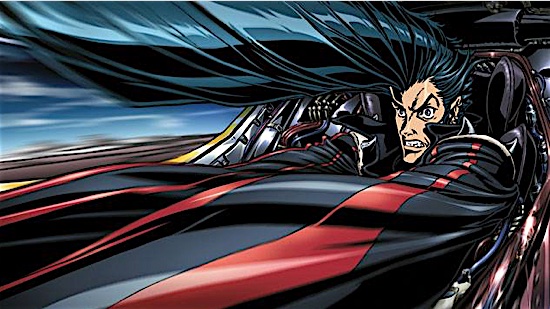
Without question, Takeshi Koike is one of the greatest animators alive and working today. Problem is, you’ve probably never heard of him. Not surprising, considering his most critically recognized work was not produced until well into his late thirties. Recruited by studio Madhouse straight out of high school in 1986, Koike became something of a protégé to veteran director Yoshiaki Kawajiri and cut his teeth as an inbetween animator for such films as Cyber City Oedo 808 and Ninja Scroll before striking out on his own projects during the 2000s. After directing projects such as Trava: Fist Planet, The Animatrix short “World Record,” and the pilot for Afro Samurai, Koike poured the sum total of his talents into creating what is now popularly considered his opus: Redline, a stylistically bold high-octane racing adventure nearly seven years in the making. Koike’s style is unmistakable, with exaggerated silhouettes framed by jagged shadows, extreme focal points, and unrelenting action that recalls the works of Mike Mignola, Frank Miller and Peter Chung. Redline is a feast for the senses, a no-holds-barred visual spectacle with every framed packed with innocuous intricacies rendered in meticulous loving detail. The story is threadbare, no doubt, but as a film that triumphantly pays off its protracted gestation period with a product that’s this unabashedly impressive and downright cool, Redline squarely fits into the select number of anime films that one just has to see before they die.
18. Belladonna of Sadness (1973)
Director: Eiichi Yamamoto
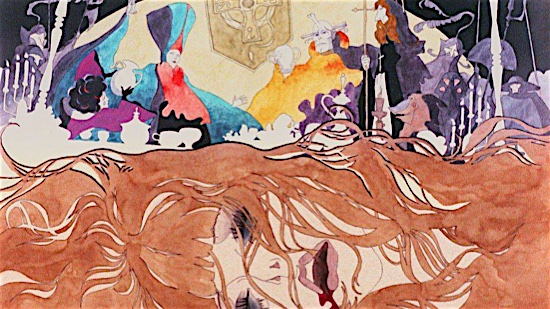
Inspired by Jules Michelet’s book Satanism and Witchcraft, the third and final film in Osamu Tezuka’s “Animerama” trilogy was so expensive and avant-garde, its failure bankrupted its production company, Mushi Pro. The only film in the trilogy not directed by Tezuka (he left the project in its conceptual stages), Eiichi Yamamoto’s Belladonna of Sadness is amongst the most unusual animated films ever put to celluloid. This is not a huge surprise from a talent as legendary as Yamamoto, among whose mighty credits are titles like Kimba the White Lion and Space Battleship Yamato. Belladonna of Sadness is the tale of a village woman named Jeanne who is raped by her liege lord and his men on her wedding night, then makes a literal deal with the devil to gain magical powers and lead a rebellion against her rapists. Belladonna is extreme in every sense of the word: Start with the look—the film consists almost entirely of pans across still watercolor paintings, with occasional expressive bursts of color and movement scattered throughout. The designs owe virtually nothing to traditional anime character construction, or even Tezuka’s own, more cartoonish style. Instead, the film’s great debt is to European painters like Gustav Klimt, Degas and Kandinsky, among others. Filled with haunting music, lots of disembodied voice-over and vibrantly rendered yet horrifying scenes of rape, nudity, murder and madness, it’s no surprise Belladonna of Sadness was banned in many countries for decades. The feminist subtext of the film is very much foregrounded—clearly Jeanne is an avatar for Jeanne D’Arc (Joan of Arc), and there are also direct links in one scene between Jeanne and Marianne, the female personification of the French Republic—and despite the darkness Jeanne wallows in and the horrors she is subjected to, this is a film worth experiencing, mostly because there has really been nothing like it either before or since. The tale is brutal, but the beauty in which it’s told means we can’t look away. —Jason DeMarco
17. Millennium Actress (2001)
Director: Satoshi Kon
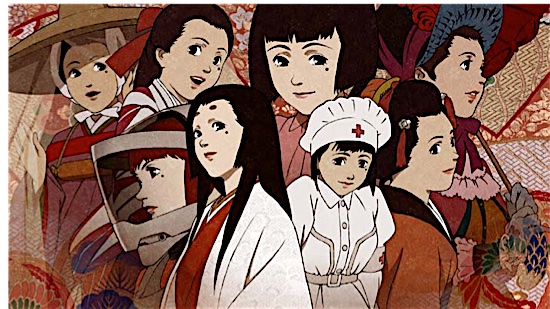
Satoshi Kon’s second film, Millennium Actress, builds off the themes of cinema and celebrity previously explored in his debut Perfect Blue, instead casting them in the mold of a metafictional fairytale quest for love. Inspired by the lives of Setsuko Hara and Hideko Takamine, two of Japan’s premiere early-century stars, Millennium Actress follows the story of Chiyoko Fujiwara, a reclusive septuagenarian who recounts the story behind her illustrious career as a film actress when approached by a pair of interviewers eager to film a documentary. One of Kon’s signature motifs as a director is the mutability of reality and fantasy, exploring how the two constantly dovetai into one another, creating works that speak to the multiplicity of the human experience. Millennium Actress is a prime example of this, with the film’s presentation constantly assaulting the fourth wall, blending factual events and cinematic flair until the two are inseparable. Unlike most of his contemporaries, Kon was not satisfied to look only toward the insular vacuum of genre anime for inspiration, but instead looked to such works as George Roy Hill’s 1972 adaptation of Slaughterhouse-Five, a film whose use of scene cuts and transitions play a huge role in distinguishing Millennium Actress among other films of its time. Combining references to the physical comedy of Buster Keaton, Akira Kurosawa’s Throne of Blood and Hiroshi Inagaki’s Rickshaw Man, Millennium Actress is a testament to Kon’s enduring love of cinema. It deserves to be seen, examined and cherished for years to come.
16. Super Dimension Fortress Macross: Do You Remember Love? (1984)
Director: Shoji Kawamori, Noboru Ishiguro
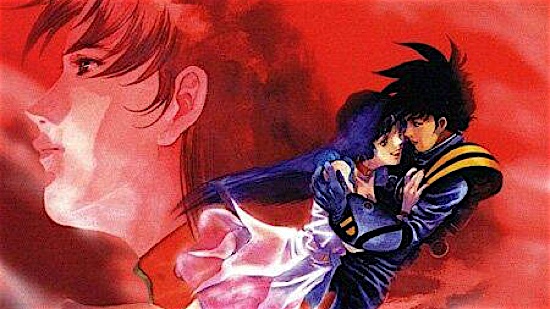
Shoji Kawamori’s Macross, known in the United States as Robotech, has a convoluted history both in its country of origin and here in the states. The first Macross movie, 1984’s Macross: Do You Remember Love? further complicated the Macross legacy. The film is essentially a reimagining of the (at the time) popular TV series, Macross. Like the show, the film centers around the crew of a giant space fortress, Macross, as they attempt to evade an alien race, the Zentradi, and discover that the key to their victory just might be the effect that Earth-made pop music has on their enemy. Yes, you read that right. The film’s other focus is the love triangle between dashing pilot Hikaru Ichijyo, pop idol Lynn Minmay, and lieutenant Misa Hayase. Although the cast of characters and voice actors are the same as those that appear in the TV series, and the plot covers much of the same ground, within the canon of the Macross universe, Do You Remember Love? is actually a popular, fictionalized retelling of the true events that occurred in the series. Regardless, Macross: Do You Remember Love? nails everything great about the show—gorgeous mecha designs, excellent dramatic (if a little over the top) storytelling, and an alternatively infuriating and captivating love triangle—and does so in a little over two hours. If you’re looking to understand the appeal of Macross, this is the place to start. In many ways it is typical of its time, in terms of character design, themes and the plot device of a band of humans on the run from an alien menace. Yet it is an incredibly well designed, directed and animated film that retains its sense of adventure even in the context of the somber overall plot. A massive hit in Japan, it has never had an uncut, official release in the United States due to legal squabbles between Harmony Gold, the American rights holder for Macross, and various Japanese production entities. The original film was a huge hit in Japan, with lines stretching around the block on the weekend of its premiere, and is now considered a classic. It’s hard to track down for U.S. fans, but well worth the effort for anyone looking for a good space opera … and pop music good enough to defeat an alien race. —J.D.
15. Metropolis (2001)
Director: Rintaro
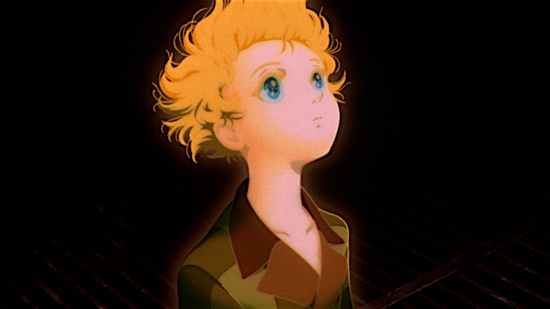
Not to be confused with Fritz Lang’s landmark 1927 sci-fi film of the same name, Metropolis is instead a loose adaptation inspired by Osamu Tezuka’s 1949 manga, which itself was inspired in part by Lang’s aforementioned opus. Written by Katsuhiro Otomo and directed by Rintaro, the film’s aesthetic and themes share more than a passing resemblance to Otomo’s genre-defining Akira. Set in the titular multi-layered megacity amid social upheaval between the human bourgeoisie and the robotic working class, Metropolis follows the story of private detective Shunsaku Ban and his nephew Kenichi who, while visiting Metropolis on their mission to apprehend the nefarious Dr. Laughton, happen upon a mysterious robotic girl named Tima whose existence may in fact hold the key to either the city’s salvation or destruction. Much like Akira, Metropolis is a sprawling epic of intersecting storylines, sweeping set pieces, and monolithic settings packed with a dense array of intricate details and beautiful color palettes. Decidedly darker than Tezuka’s manga, the film is neither an adaptation of either that or Lang’s film but rather an attempt to expand upon the inspiration of the two. A high-flying sci-fi adventure that doubles as social commentary for the shared struggle and seemingly inevitable antagonism between factions of the lower working class and humankind’s hubristic quest for power and control of a world that dwarfs their ambitions. Metropolis may not have struck big at the box office—only earning $4 million towards its $15 million budget—and it may not resonate with the same cult classic recognition as films like Ghost in the Shell or Ninja Scroll, but it remains an immense achievement by two of the greatest anime directors alive who sought to both honor and surpass the work of one of the most influential anime pioneers of all-time.
14. Barefoot Gen (1983)
Director: Mori Masaki
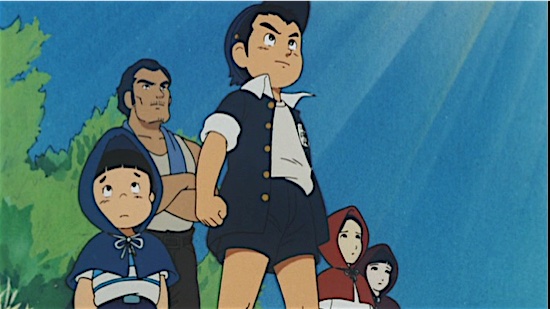
There is perhaps no more catastrophically significant event in modern Japanese history than that of the nuclear bombardment of Hiroshima and Nagasaki during World War II. Keiji Nakazawa’s 1973 semi-autobiographical manga Barefoot Gen is a testament to this event, depicting one young boy’s struggle to survive in the wake of witnessing his friends and family gruesomely disintegrated by the indiscriminate force of a nuclear impact. Mori Masaki’s adaptation takes Nakazawa’s original and brings it to life on screen, delivering a harrowing snapshot of one of history’s most horrific instances of mass annihilation. The fateful scene where the Enola Gay detonates the bomb over Hiroshima is breathtaking and heart wrenching, as six-year old Gen’s home is pummeled in a shockwave of devastating power before subsiding into a plume of atomic hellfire. But to reduce Barefoot Gen’s significance to that of only being destruction porn created to induce guilt would be disingenuous. The film is, all in all, a human story of resilience and stubborn hope in the face of annihilation, and hopefully can be looked back upon as a sobering reminder of the costs of unremitting warfare and what we all still have to lose if we were to forget the lessons of the past.
13. Pom Poko (1994)
Director: Isao Takahata
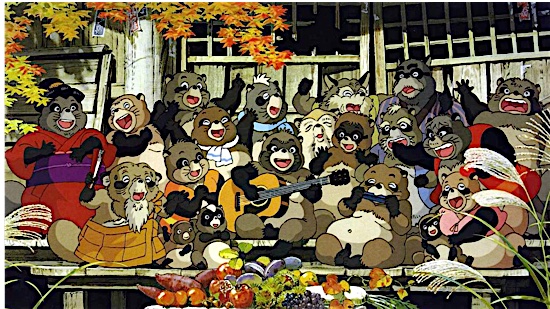
Pom Poko is the type of film that feels inconvertible from its cultural origin. Forget trying to make this one more palatable for Western sensibilities, Pom Poko doubles down on the qualities that identify it as Japanese film and brandishes them proudly for all to see. Although better known for his realistic human dramas rendered through increasingly more experimental animation techniques, Pom Poko is Isao Takahata’s first foray into full-on fantasy farce, depicting the story of a clan of Japanese raccoon dogs (known as “tanuki”) whose home is ravaged by urban development. Emboldened both to defend their home and possibly learn to peacefully coexist alongside the humans, the tanuki retrain themselves in their lost ancestral ability of transformation to disguise themselves in modern society. But what distinguishes Pom Poko as such a unique cultural curiosity? The answer is simple: balls. Or, to be more descriptive, the on-screen prominence of the tanuki’s testicles as they use them in increasingly more inventive ways to disguise or defend themselves. Though surprisingly non-explicit and unquestionably coded as a children’s comedy film, this aspect might turn off potential audiences from exploring it and perhaps explains why the movie is relatively so unknown even among ardent of Studio Ghibli fans. Still, Pom Poko is a brilliant slapstick take on traditional Japanese mythology—something of a cross between Watership Down meets The Gods Must Be Crazy—that’s full of zany and inventive animation and genuine emotional depth. If you’ve always yearned in your heart of hearts for a Studio Ghibli film where a pack of anthropomorphic raccoons use their gigantic testicles as bludgeoning weapons in a last stand against police officers, rest assured because your prayers have been answered.
12. Princess Mononoke (1997)
Director: Hayao Miyazaki
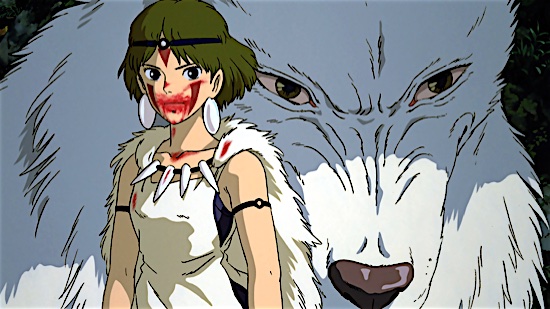
One persistent theme across all of Studio Ghibli’s work, in particular Miyazaki’s, is that there rarely are any true villains. This sentiment is perhaps most apparent in Princess Mononoke, Miyazaki’s seventh film and notably one of his darkest. Set during the early 16th century, the film follows the story of Ashitaka, the last remaining prince of a small eastern village who is wounded while defending his home from a wild boar overtaken by a malicious spirit. Mortally cursed with no hope of a cure, Ashitaka takes it upon himself to journey to the West and discover and halt whatever malevolent force is causing this havoc. What he finds there is more complicated than he could have imagined: a settlement of humans mining the region to build a home while fending off the forces of the nearby forest who see their world being destroyed. Later he meets San, a young woman raised by the clan of wolves who defend the forest as he attempts to broker an uneasy peace between the two sides. Princess Mononoke is the epitome of Miyazaki’s appeal to environmentalism, melding traditional fantasy and Japanese folklore to create the director’s most serious and adult-oriented work to date. The film’s violence is a sharp divergence from Miyazaki’s relatively goreless body of work, with limbs being severed with callous abandon and wild boar gods weeping blood as they trudge on a death march through the forest. It’s an exhilarating, heartbreaking and colossal film whose message will leave audiences changed by its final scene. Quite simply, it is everything that one would come to expect from the pedigree of Hayao Miyazaki.
11. Royal Space Force: The Wings of Honnêamise (1987)
Director: Hiroyuki Yamaga
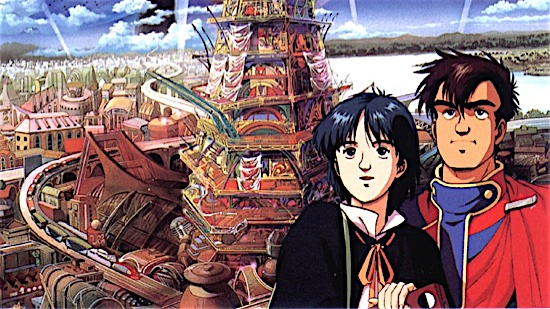
In 1987, an upstart Japanese studio called Gainax pitched Bandai Visual on the idea of a very expensive animated film about an alternate reality in which two nation states, torn by war, struggle to be first to develop manned space flight in an industrialized society. Bandai Visual, who was looking to break into the film market, liked the idea, and thus Royal Space Force: The Wings of Honnêamise was put into production, for the (at the time) massive price tag of 8M yen. The result is essentially a two-hour art film, a rumination on man’s capacity for greatness and evil that would end up as one of the most visually detailed animated films ever made … and a flop at the box office. The story concerns a young man, Shirotsugh Lhadatt, who joins the much derided “Space Force” of his nation state, Honnêamise, which is locked in perpetual war with a rival nation, The Republic. We witness Shirotsugh’s growth as a person and his journey to become an astronaut as well as his budding relationship with Riquinni Nonderaiko, a young woman whose excitement about what the space program symbolizes ignites Shirotsugh’s own passion. Perhaps one reason why The Wings of Honnêamise is rarely spoken of as a masterpiece these days is the widespread critical rejection of one particular scene, which (rightfully) has sharply divided audiences over the years. In this scene, Shirotsugh makes his way to Riquinni’s house and comes close to raping her before realizing the horrible thing he is about to do, and stopping himself. He apologizes to Riquinni, who essentially tells him it was her fault for leading him on. The reasons for, and meaning behind, the attempted rape scene and what it’s supposed to say about Shirotsugh are sound, but the reaction of Riquinni makes no sense in context of the story, and very much smacks of ’80s Japanese cultural misogyny. Obviously, watching these scenes with today’s sensitivities in place will make them seem even more pointlessly barbaric. Even so, regardless of how one feels about this particular scene, the rest of the film is well worth critical evaluation. If The Wings of Honnêamise is a “noble failure,” it’s the sort of failure many filmmakers would kill to have on their résumé. —J.D.
10. Neo-Tokyo (1987)
Director: Various
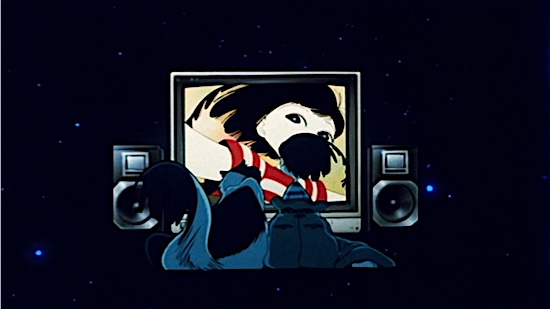
Released in 1987 under the original title of Manie-Manie: Labyrinth Tales, Neo-Tokyo is anthology omnibus featuring shorts directed by three of the most prolific anime directors of the late-’80s: Rintaro, Yoshiaki Kawajiri, and of course, Katsuhiro Otomo. The collection was later renamed by Streamline Pictures upon its re-release in 1989 to suggest a non-existent tie-in to Otomo’s critically acclaimed Akira, which had seen a limited North American release that year. Rintaro’s “Labyrinth Labyrinthos” draws inspiration from German Expressionism and the works of Salvador Dali, depicting the story of a mischievous young girl named Sachi as she and her pet cat Cicerone are drawn into a dark dimension of hallucinatory oddities through the looking glass of her mother’s dresser. Yoshiaki Kawajiri’s “The Running Man” is a grim sci-fi noir short inspired by Blade Runner told from the perspective of a sports reporter who witnesses the final race of Zach Hugh, the fabled star of a deadly racing tournament who slowly develops deadly psionic abilities. The final short, “Construction Cancellation Order,” is arguably the anthology’s best and most accessible entry. Directed by Otomo, the short follows Tsutomu Sugioka, a Japanese salaryman dispatched by his superiors to the remote (and fictitious) South American country of the Aloana Republic to shut down their remote construction designated Facility 444. Labelled by both fans and critics alike as anime’s equivalent to Francis Ford Coppola’s Apocalypse Now, the short is indicative of Otomo’s social satire period, which would later produce Roujin-Z, taking pointed aim at the bureaucratic absurdity of Japanese working society. Though for the most part absent of any real thematic connectivity, Neo-Tokyo is a concise and powerful example of the dizzying heights of technical mastery and aesthetic ambition anime can achieve when put in the hands of the medium’s most inimitable creators.
9. My Neighbor Totoro (1988)
Director: Hayao Miyazaki
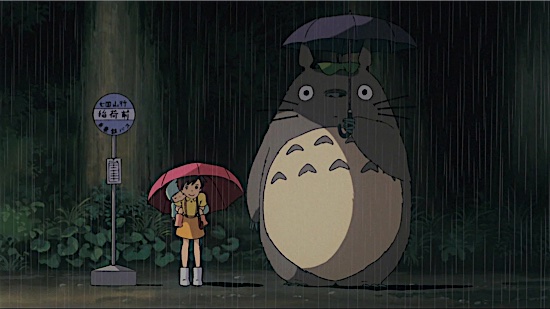
My Neighbor Totoro is not only Miyazaki’s most iconic film to date, it’s also an all but perfect family film that manages to distill the essence of childhood whimsy down to its purest state. The film has a sort of timeless appeal about itself, disarming audiences new and old of their cynicisms and suspicions with beautiful settings, empathetic characters, and an infectious marching band theme. Set in 1958, the film follows university professor Tatsuo Kusakabe and his daughters Satsuki and Mei as they move into an old house along the countryside in order to be closer to their mother, who is recovering from a long illness. We see the world through the girls’ eyes: leaping through the fields along the house, chasing skittering dust mites, and tumbling down holes in the base of trees to land safely on the bulbous stomach of a benevolent spirit animal. My Neighbor Totoro was revolutionary for its time for luxuriating on quiet contemplative moments in a time when most of anime was otherwise dominated by the chase from one flash to the next spectacle. The late film critic Roger Ebert described it best, “My Neighbor Totoro is based on experience, situation and exploration—not on conflict and threat.” It’s a film sprung fully formed from the imagination of a master animator, a movie about the everyday magic of being a child and the simple power of meeting the world with an open heart.
8. Patlabor 2 (1993)
Director: Mamoru Oshii
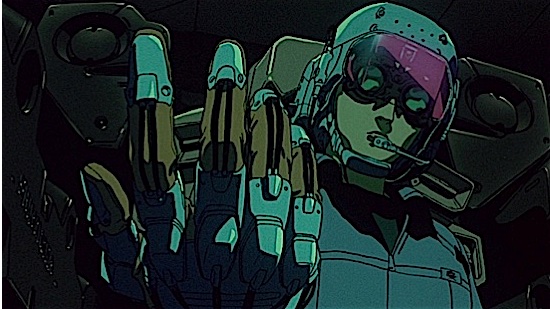
Patlabor 2 is Mamoru Oshii’s most formative work, an atmospheric political thriller that set the template for the aesthetic and mood that would later become his signature and distinguish the tone and substance of his most famous work, Ghost in the Shell. Set three years after the original, Patlabor 2 once again follows the Tokyo Metropolitan Police Department’s 2nd Special Vehicles unit as they are drawn into the throes of another crisis, this time concerning a rogue military commander’s plot to orchestrate a controlled state of fear and panic through which to mount a coup d’etat to overthrow the government. Where in his previous films, Oshii only flirted with political commentary that was otherwise relegated to the margins of more standard pop-action plotlines, Patlabor 2 is a full-on political thriller that’s low on giant robot showdowns and heavy on ambiance, emotion and careful pacing. It’s a work of consummate technical achievement, maturity and philosophical poignance as enduring today as it was nearly twenty-three years ago. It is the culmination of a master animator coming into the fullness of his creative faculties and the spiritual preface to the film that would later go on to become his magnum opus.
7. Perfect Blue (1997)
Director: Satoshi Kon
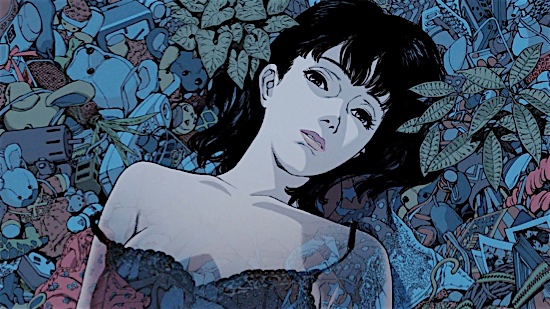
Perfect Blue is a precious rarity in the genre-saturation of contemporary anime: an honest-to-god psychological horror thriller brimming with malice, menace and cinematic sophistication. Adapted from Yoshikazu Takeuchi’s 1991 novel, Satoshi Kon’s feature debut follows Mima Kirigoe, a singer who retires from the pop-idol trio that gained her fame to pursue a career as an actress. As the pressures of her new career begin to take their toll, a string of vicious murders perpetrated by a mysterious assailant who claims to be an agent of the “real” Mima begins to encircle the set of her first big role. As the boundaries between her private and public life begin to blur, Mima’s grip on reality begins to fray as she stumbles spirals deeper into a tailspin of depression and madness. An avowed cinephile, the most visible influences for Kon’s work on Perfect Blue are unmistakably that of Alfred Hitchcock’s Psycho and Jonathan Demme’s The Silence of the Lambs. Dario Argento’s 1977 giallo classic Suspiria is also cited by fans and critics as a possible spiritual inspiration, though Kon himself denied having seen any of Argento’s films before hearing these comparisons. With exquisitely inventive editing, thoughtful color direction, and a gripping plot, Kon delivered a strong first outing as a director that would set the bar for his tremendous decade-spanning career. Though ostensibly a film about inherent toxicity of pop culture in manufacturing idols with same infatuation as it would destroy them, Kon was by and large unconcerned with the surface reading of his work. His interest was found beneath the folds of easy answers and trite moralizations to lay bare the truth that, as one of his characters quotes from a script, “there are no fixed truths about ourselves, only a continuous stream of memories to be ordered and rationalized.”
6. The Wind Rises (2013)
Director: Hayao Miyazaki
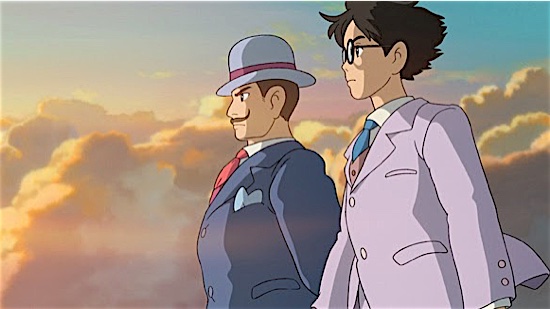
Of all of Miyazaki’s most persistent tropes and motifs, there are none more consistently threaded throughout the body of work than that of the depiction of flight. So it’s no surprise that The Wind Rises, his eleventh and final feature film to date, would focus squarely on depicting the life of Japanese aviation engineer Jiro Horikoshi and the complicated legacy his creations relate not only to the pacifist cultural identity of contemporary Japan but also, on a personal level, to Miyazaki himself. A story of how a creator cannot control what their work becomes, only the dedication and craft to which they pour into the work itself. The Wind Rises is nothing short of Miyazaki’s final artistic testament to humanity’s paradoxical capacity for both the redemptive act of creation and dogged pursuit of self-annihilation. A film that is in no uncertain terms a conclusion, if not to Miyazaki’s venerable career as one of the undisputed patriarchs of modern Japanese animation, then a thematic coda that ties together an elegant knot at the end of his venerated and storied career as a director.
5. Paprika (2006)
Director: Satoshi Kon
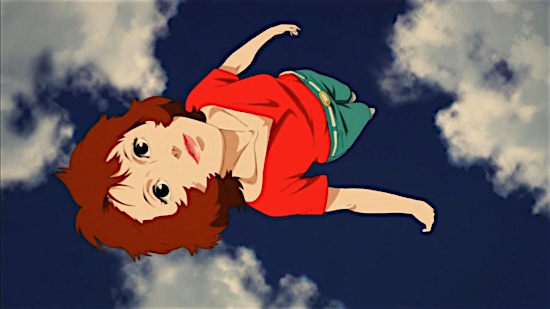
In a career of impeccable films, Paprika is arguably Kon’s greatest achievement. Adapted from the 1993 novel by Yasutaka Tsutsui (whose other notable novel, The Girl Who Leapt Through Time, would form the basis of Mamoru Hosoda’s 2006 film of the same name), Kon could not have asked for source material that better suited his thematic idiosyncrasies as a director. Paprika follows the story of Atsuko Chiba, a psychiatrist working on revolutionary psychotherapy treatment involving the DC Mini, a device that allows the user to record and navigate one’s dreams in a shared simulation. By day Atsuko maintains an unremittingly cold exterior, but by night she moonlights as the film’s titular protagonist: a vivacious dream detective who consults clients on her own terms. When a pair of DC Minis are stolen and loosed upon the world, causing a stream of havoc which manifests the collective unconscious into the waking world, it’s up to Paprika and her colleagues to save the day. The summation of Kon’s decade-long career as a director, Paprika is a cinematic trompe l’oeil of psychedelic colors and exquisite animation. Kon’s transition cuts are memorable and mind bending, the allusions to his immense palate of cinematic influences are savvy, and his appeal to the multiplicity of the human experience as thoughtful and poignant as ever. Unfortunately, Paprika would turn out to be Kon’s last film, as he would later tragically pass away in 2010 from pancreatic cancer. One fact remains evident when looking back on the sum total of his life’s work: Satoshi Kon was, and remains, one of the greatest anime directors of his time. He will be sorely missed.
4. Ghost in the Shell (1995)
Director: Mamoru Oshii
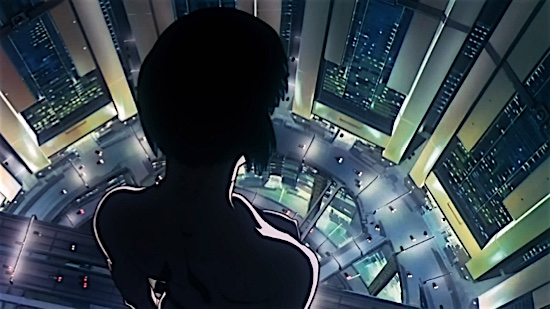
It’s difficult to overstate how enormous of an influence Ghost in the Shell exerts over not only the cultural and aesthetic evolution of Japanese animation, but over the shape of science-fiction cinema as a whole in the 21st century. Adapted from Masamune Shirow’s original 1989 manga, the film is set in the mid-21st century, a world populated by cyborgs in artificial prosthetic bodies, in the fictional Japanese metropolis of Niihama. Ghost in the Shell follows the story of Major Motoko Kusanagi, the commander of a domestic special ops task-force known as Public Security Section 9, who begins to question the nature of her own humanity surrounded by a world of artificiality. When Motoko and her team are assigned to apprehend the mysterious Puppet Master, an elusive hacker thought to be one of the most dangerous criminals on the planet, they are set chasing after a series of crimes perpetrated by the Puppet Master’s unwitting pawns before the seemingly unrelated events coalesce into a pattern that circles back to one person: the Major herself.
When Ghost in the Shell first premiered in Japan, it was greeted as nothing short of a tour de force that would later go on to amass an immense cult following when it was released in the states. The film garnered the praise of directors such as James Cameron and the Wachowski siblings (whose late-century cyberpunk classic The Matrix is philosophically indebted to the trail blazed by Oshii’s precedent). Everything about Ghost in the Shell shouts polish and depth, from the ramshackle markets and claustrophobic corridors inspired by the likeness of Kowloon Walled City to the sound design, evident from Kenji Kawai’s sorrowful score to the sheer concussive punch of every bullet firing across the screen. Oshii took Shirow’s source material and arguably surpassed it, taking an already heady science-fiction action drama and transforming it into a proto-kurzweilian fable about the dawn of machine intelligence. Ghost in the Shell is more than a cornerstone of cyberpunk fiction: It’s more essential in this day and age than it was over twenty-years ago. A story about what it means to craft one’s self in the digital age, a time where the concept of truth feels as mercurial as the net is vast and infinite.
3. Grave of the Fireflies (1988)
Director: Isao Takahata
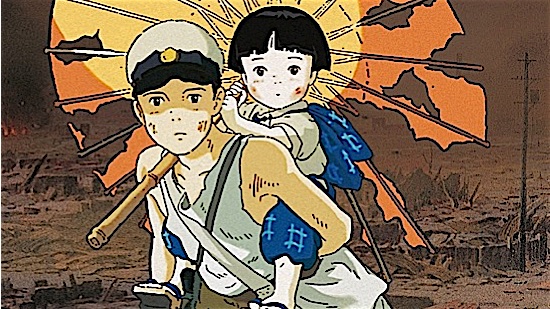
Isao Takahata’s Grave of the Fireflies is the harrowing story of two children whose lives are left devastated by the 1945 firebombing of Kobe. Adapted from the autobiographical story of Akiyuki Nosaka, the film follows Seita, a young Japanese boy forced to care for his younger sister Setsuko in the wake of a devastating Allied attack that leaves his hometown in ruins. To describe the sum of their tragedies as “horrifying” feels like a gross understatement. The horror of Grave of the Fireflies is not reliant on brooding over callous acts of violence or fixating on the macabre, but rather on the heart-wrenching futility of Seita and Satsuko trying desperately to cling to some shred of normalcy in a world devoid of peace and security. Whether it’s the scene of Seita setting eyes on his mother for the first time after the firebombing, or Satsuko inadvertently stumbling across a corpse while playing at the beach, the film raises these children’s hopes of escaping a living hell on earth as quickly as it dashes them. The film is extraordinary in that it shows the audience, with no uncertainty, that these children will perish and somehow through its hour-and-a-half running time compels the viewer to hope that this fate can be averted. Grave of the Fireflies is a chilling portrait of the fragility of human life when confronted by the indifferent brutality of an uncaring world, a film utterly unlike anything Studio Ghibli had produced before or since. Tragic in the truest sense of the word, Grave of the Fireflies is not only one of the greatest films the studio has ever produced, but unmistakably one of the greatest anime films of all time.
2. Spirited Away (2001)
Director: Hayao Miyazaki
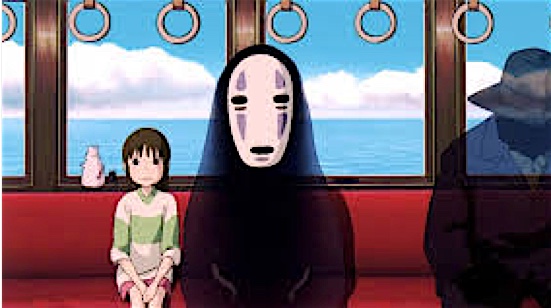
What is it about Hayao Miyazaki’s Spirited Away that makes it one of his greatest—if not the greatest—films he has ever made? Perhaps it’s because the film represents the best expression of his most defining themes and concepts to date. The strength and perseverance of a young woman, the rapturous glory of flight, the spiritual struggle of personal and cultural amnesia with Japanese society, the redeeming power of love. Or maybe it has something to do with the crux of the film’s story being so archetypically identifiable, not so much a modern reimagining as it is a spiritual evocation of Lewis Carroll’s Alice in Wonderland, a childhood odyssey in a world that feels both familiar and foreign at the same time. Whatever the case, there is nothing quite like watching Spirited Away for the first time. The image of Chihiro, having discovered her parents transformed into pigs, running frantically through the streets as the town surrounding her comes to life as lights flicker into existence and spirits rise up from the earth is nothing short of magical. Films like Nausicaä , Princess Mononoke and My Neighbor Totoro introduced the world to Hayao Miyazaki, but it was Spirited Away that secured his name among the canon of the greatest animators to have ever lived and ensured his legacy for decades to come.
1. Akira (1988)
Director: Katsuhiro Otomo
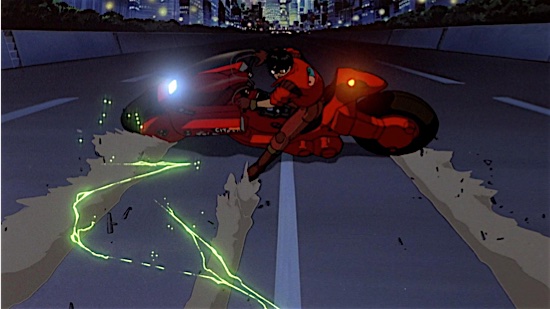
The sum total of anime cinema from the early ’90s to present day is marked by the precedent of Katsuhiro Otomo’s Akira. Adapted from the early chapters of Otomo’s landmark manga series, Akira was the most expensive animated film of its time and cinematic benchmark that sent shockwaves throughout the industry. Set thirty-one years after after World War III was sparked by a massive explosion that engulfed the city of Tokyo, Akira is set in the sprawling metropolis of Neo-Tokyo, built on the ruins of the former and teetering precariously on the cusp of social upheaval. The film follows the stories of Kaneda Shotaro and Tetsuo Shima, two members of a youth motorcycle gang whose lives are irrevocably changed one fateful night on the outskirts of the city. While clashing against a rival bike gang during a turf feud, Tetsuo crashes into a strange child and is the promptly whisked away by a clandestine military outfit while Kaneda and his friends look on, helplessly. From then, Tetsuo begins to develop frightening new psychic abilities as Kaneda tries desperately to mount a rescue. Eventually the journeys of these two childhood friends will meet and clash in a spectacular series of showdowns encircling an ominous secret whose very origins rest at the dark heart of the city’s catastrophic past: a power known only as “Akira.”
Like Ghost in the Shell that followed it, Akira is considered a touchstone of the cyberpunk genre, though its inspirations run much deeper than paying homage to William Gibson’s Neuromancer or Ridley Scott’s Blade Runner. Akira is a film whose origins and aesthetic are inextricably rooted in the history of post-war Japan, from the 1964 Tokyo Olympics and the “Anpo” student protests of that era to the country’s economic boom and the then-nascent counterculture of Bosozoku racing. Akira is a film of many messages, the least of which a coded anti-nuclear parable and a screed against wanton capitalism and the hubris of “progress.” But perhaps most poignantly, at its heart, it is the story of watching your best friend turn into a monster. Akira is almost singlehandedly responsible for the early 1990s boom in anime in the West, its aesthetic vision rippling across every major art form, inspiring an entire generation of artists, filmmakers and even musicians in its wake. For these reasons and so many more, every anime fan must grapple at some point or another with Akira’s primacy as the most important anime film ever made. Long Live Akira!
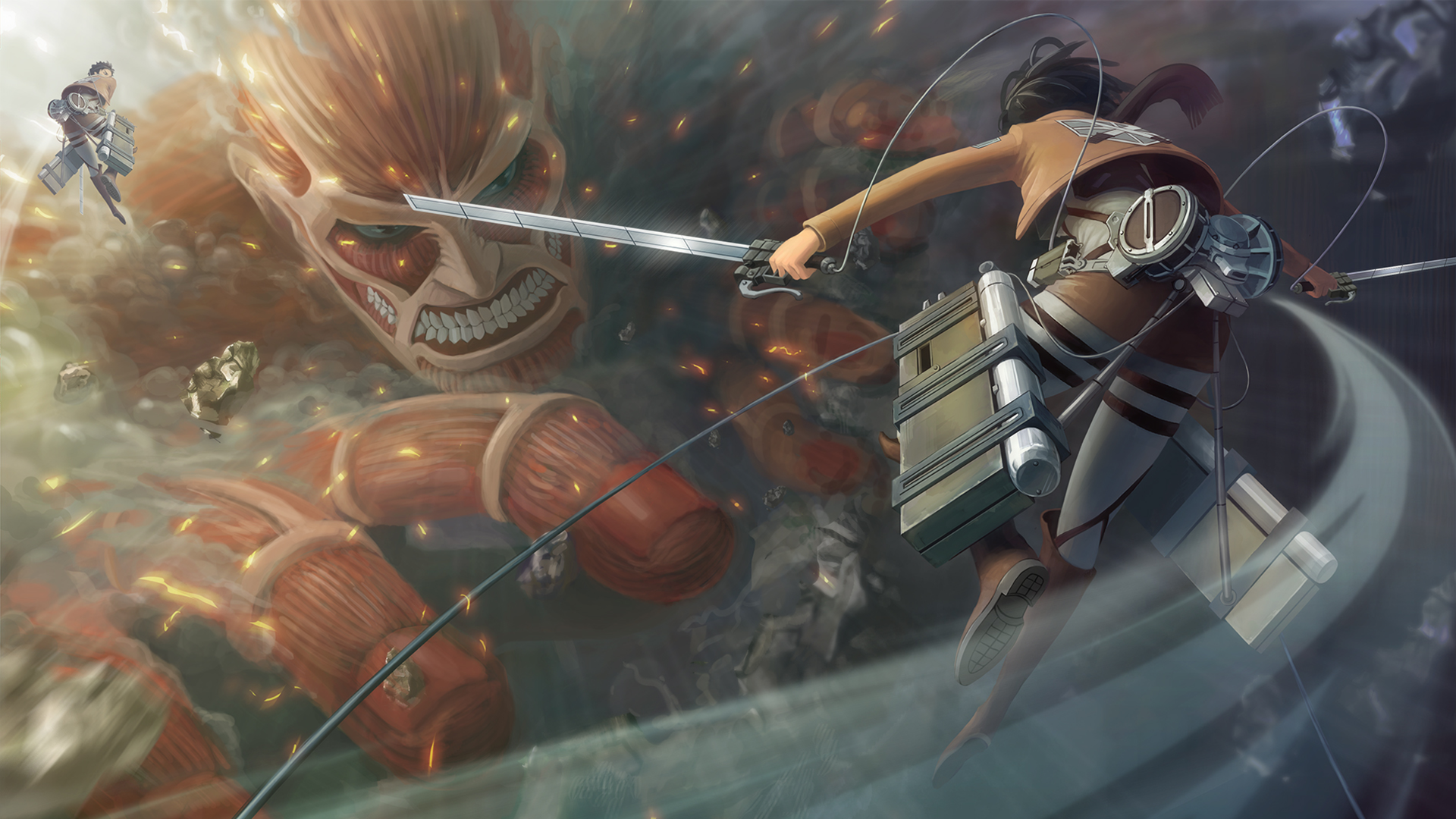 This dark fantasy series is set in a world where humanity is forced to live in a city surrounded by walls to protect themselves from Titans, giant humanoid creatures who eat people. The story follows Eren Yeager, Mikasa Ackerman, and Armin Arlert as they join the Survey Corps, a military division that fights Titans.
This dark fantasy series is set in a world where humanity is forced to live in a city surrounded by walls to protect themselves from Titans, giant humanoid creatures who eat people. The story follows Eren Yeager, Mikasa Ackerman, and Armin Arlert as they join the Survey Corps, a military division that fights Titans.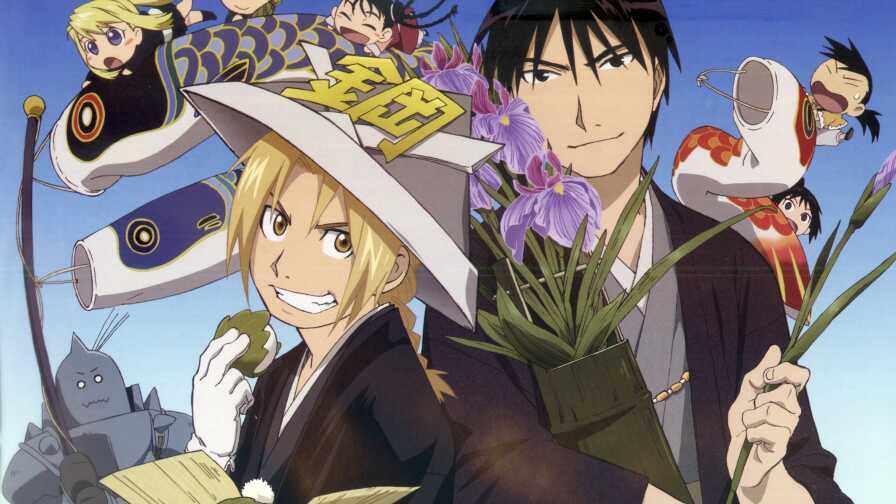



.png)
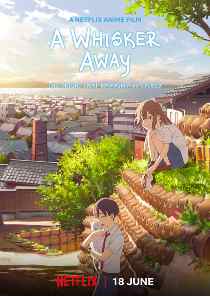 Year: 2020
Year: 2020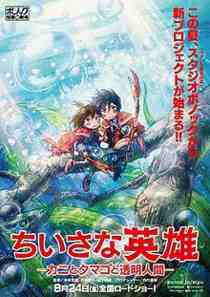 Year: 2019
Year: 2019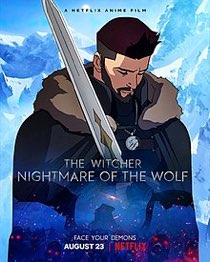 Year: 2021
Year: 2021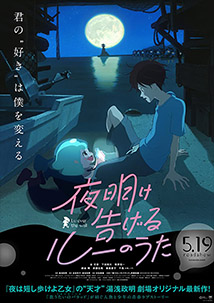 Year: 2018
Year: 2018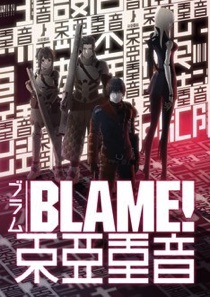 Year: 2017
Year: 2017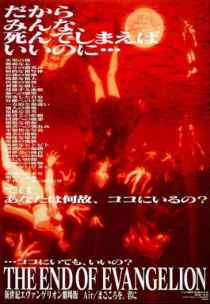 Year: 1997
Year: 1997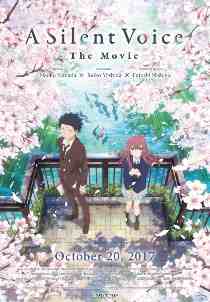 Year: 2016
Year: 2016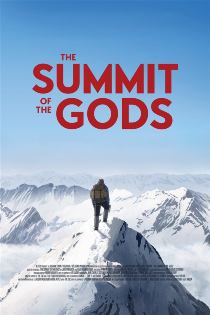 Release Date: November 24, 2021
Release Date: November 24, 2021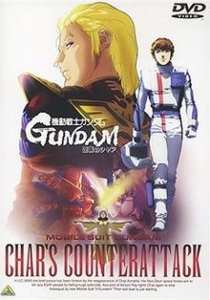 Year: 1988
Year: 1988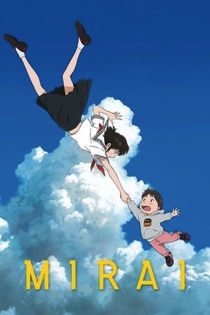 Year: 2018
Year: 2018



































































































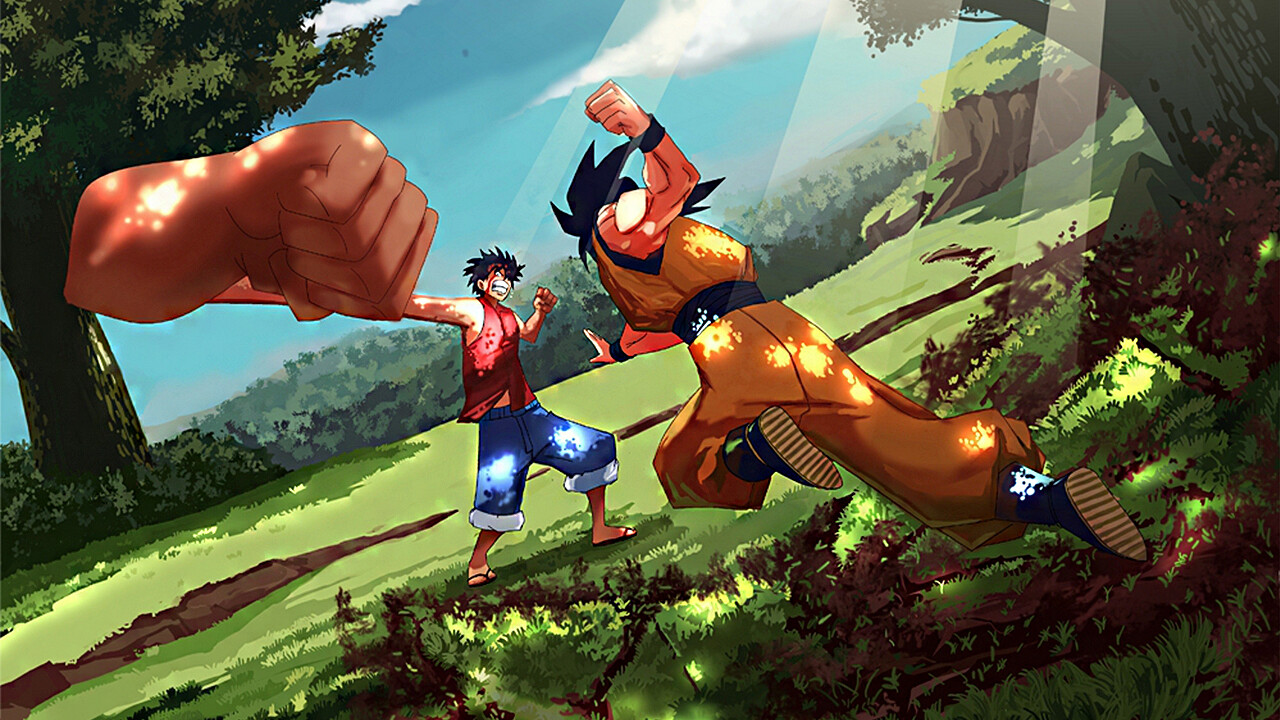
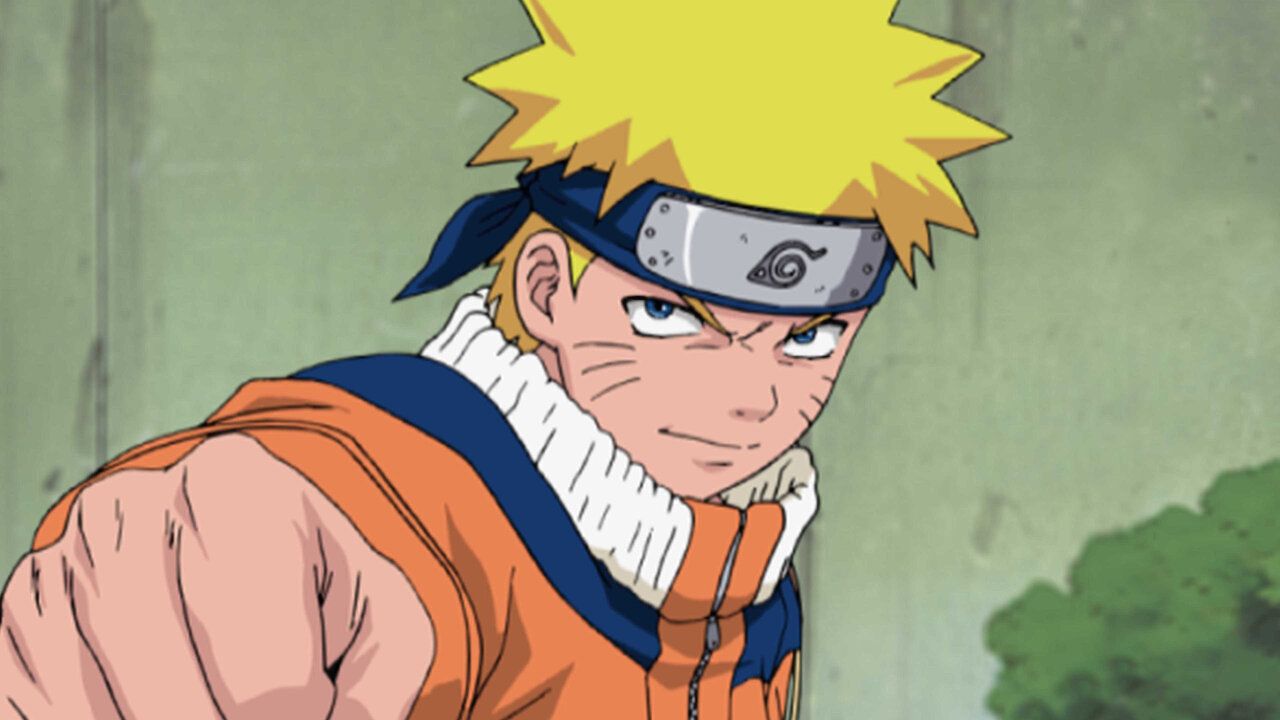

























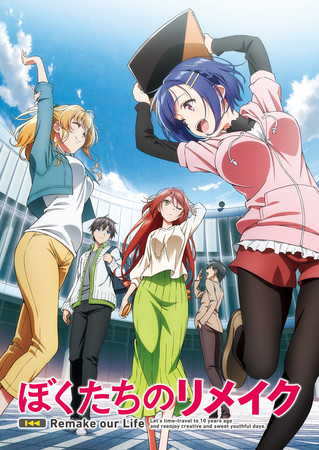 Hong Kong content distributor
Hong Kong content distributor 





